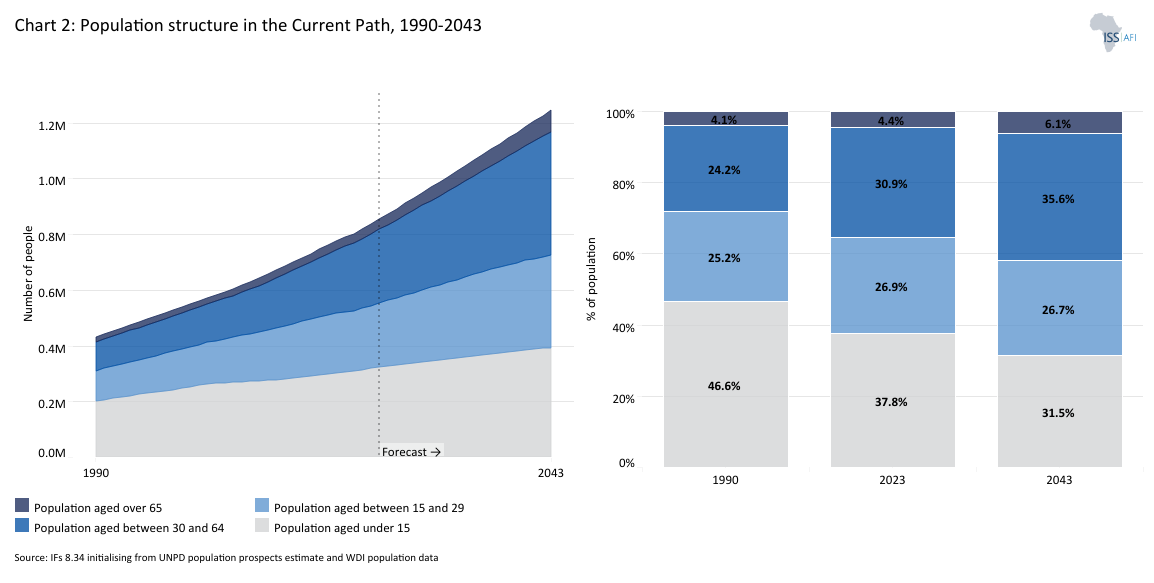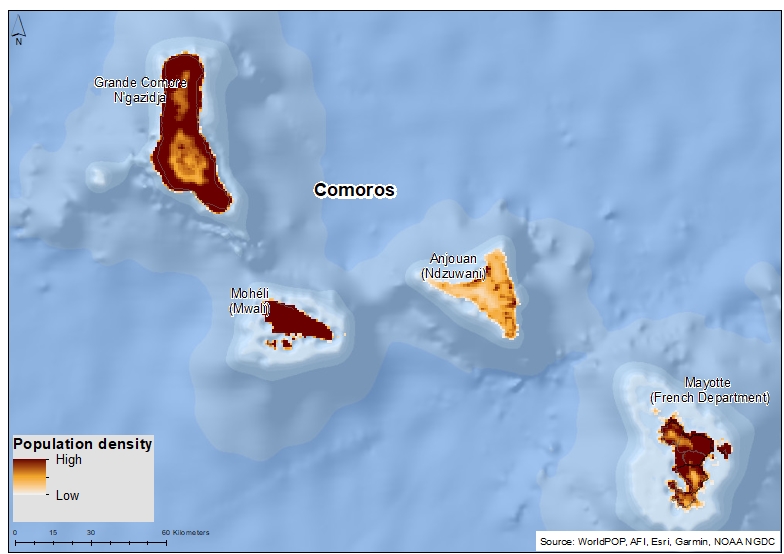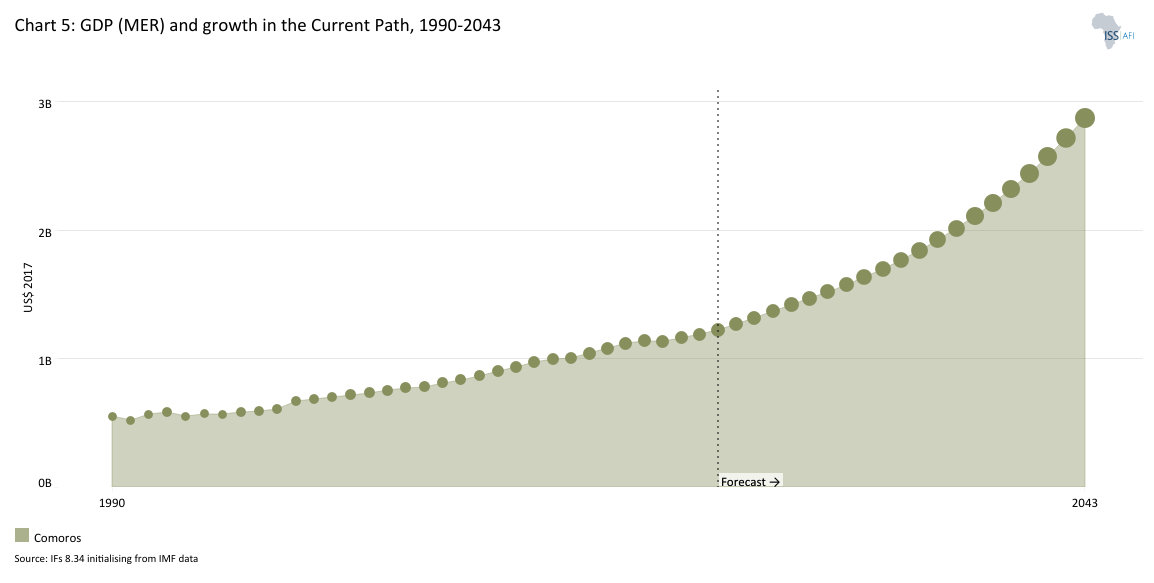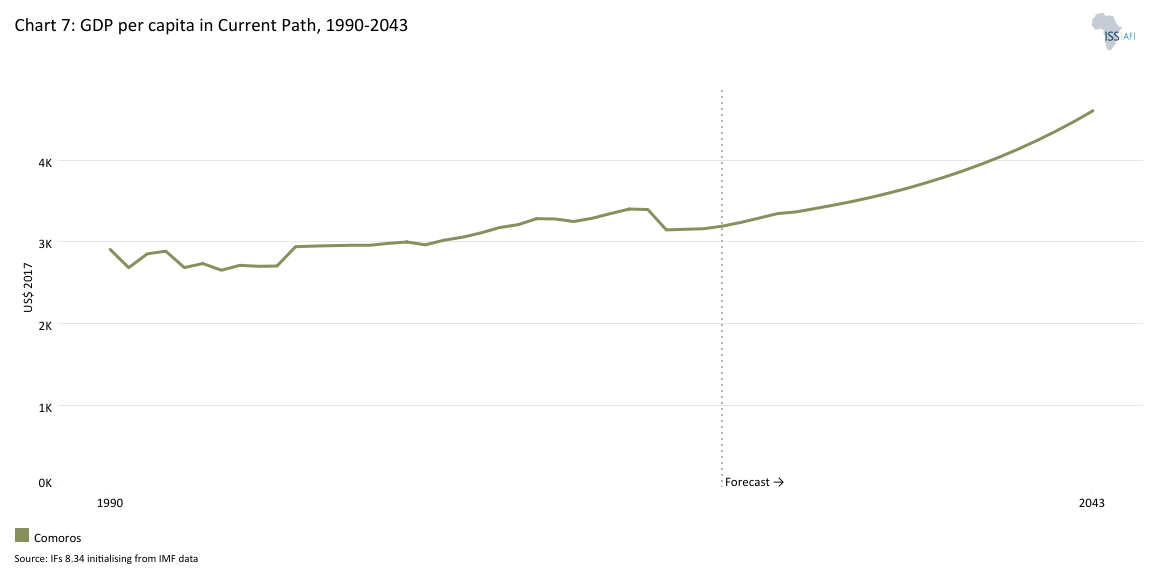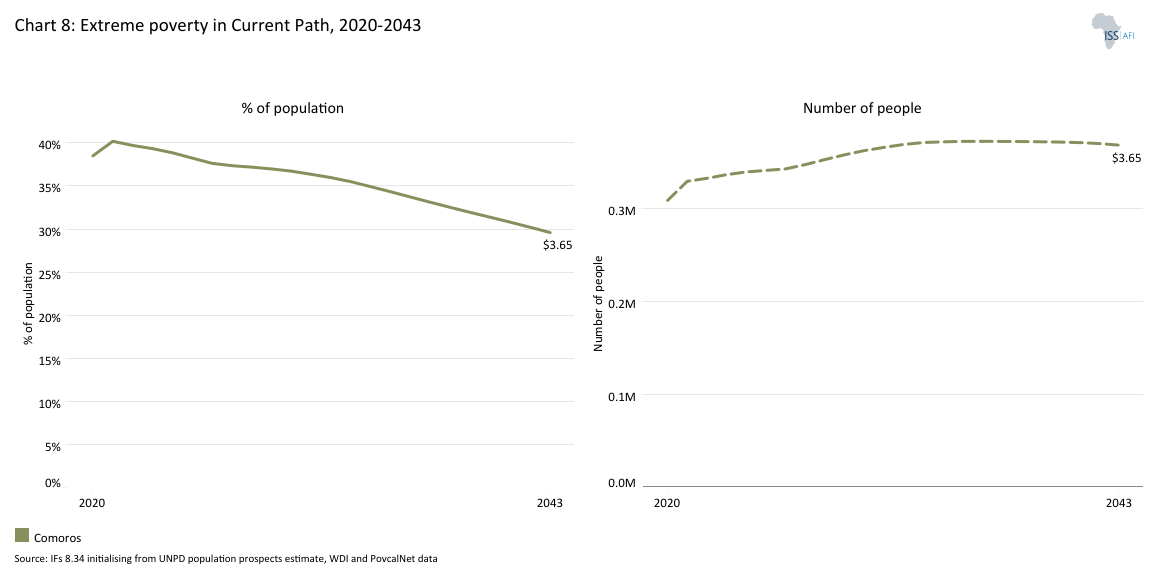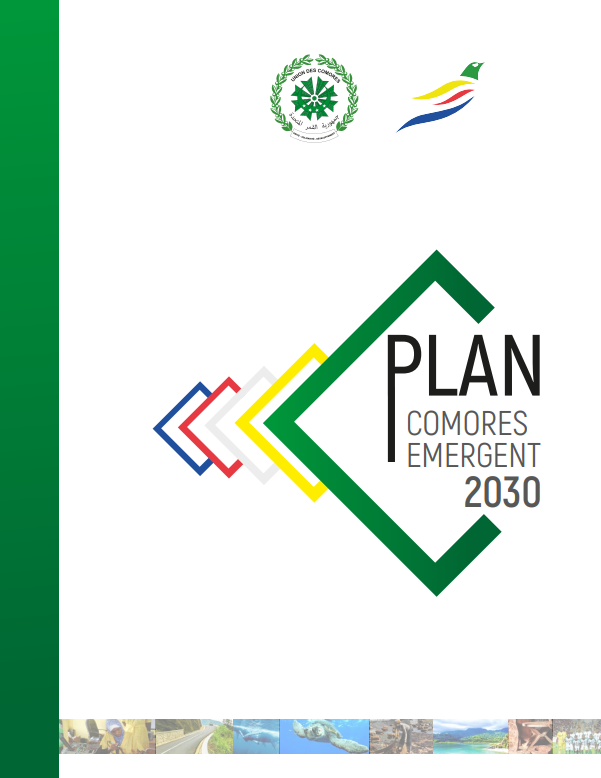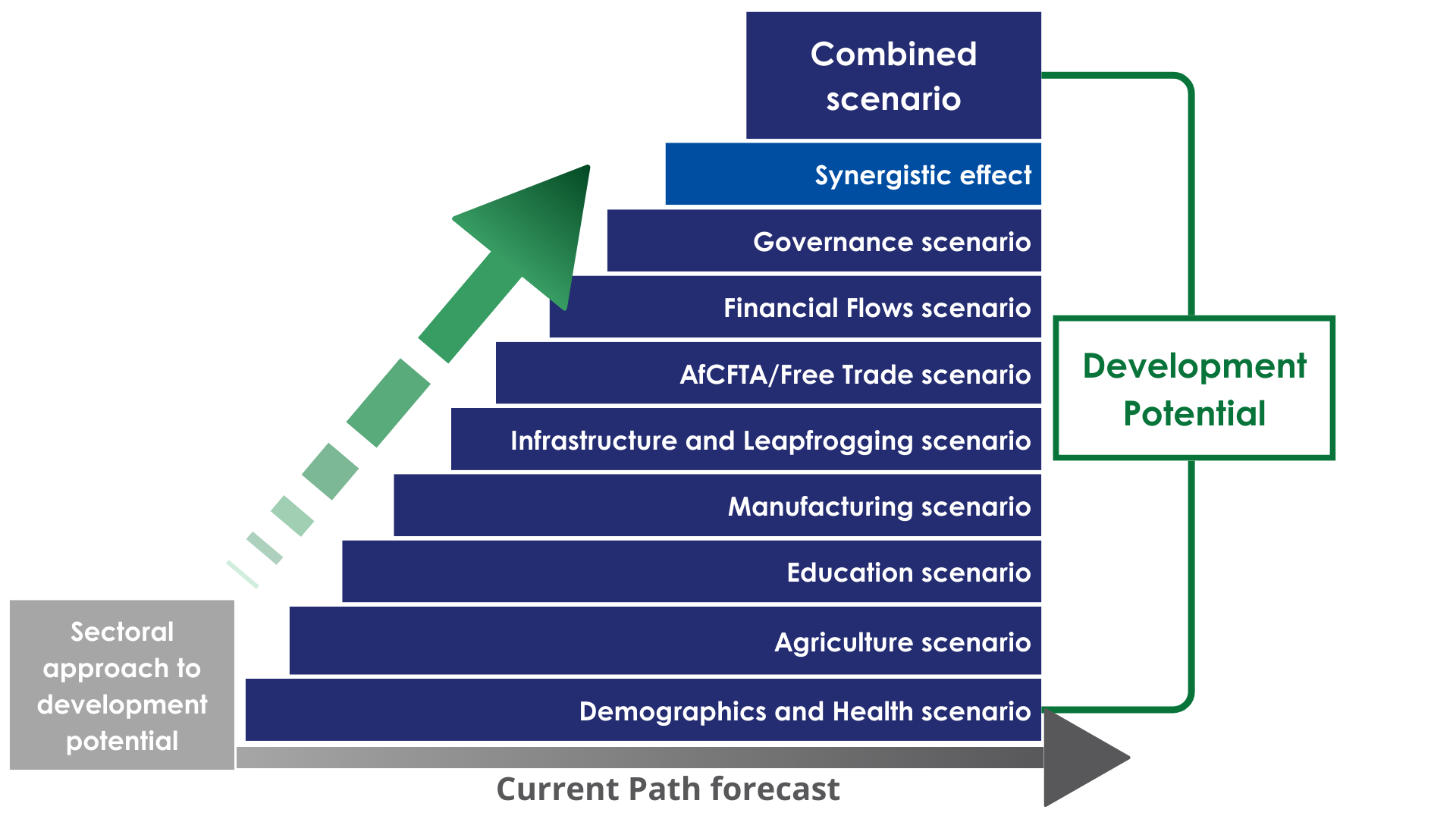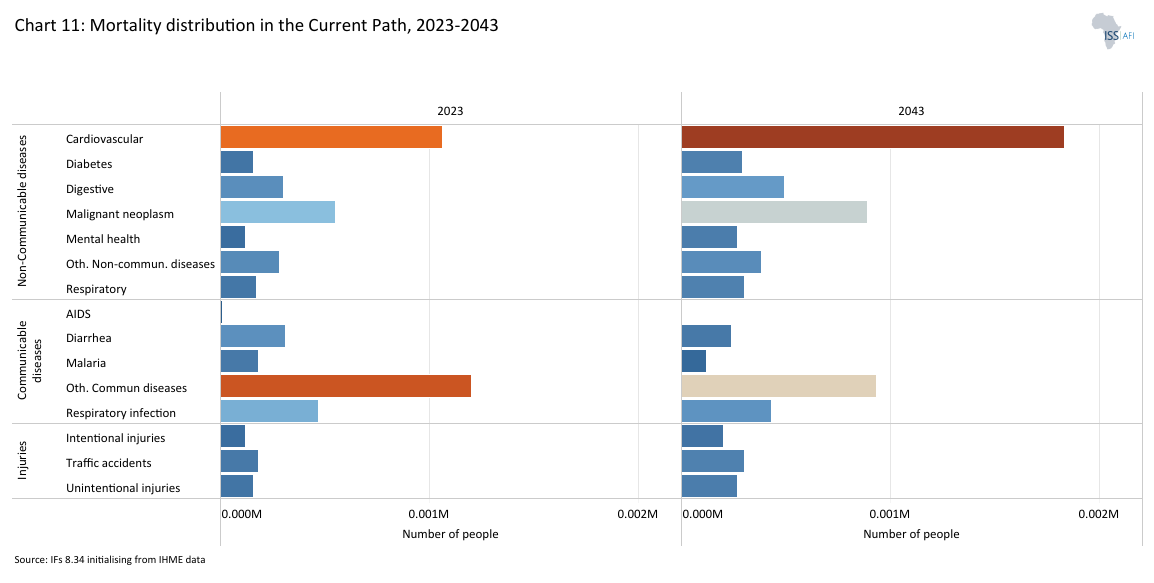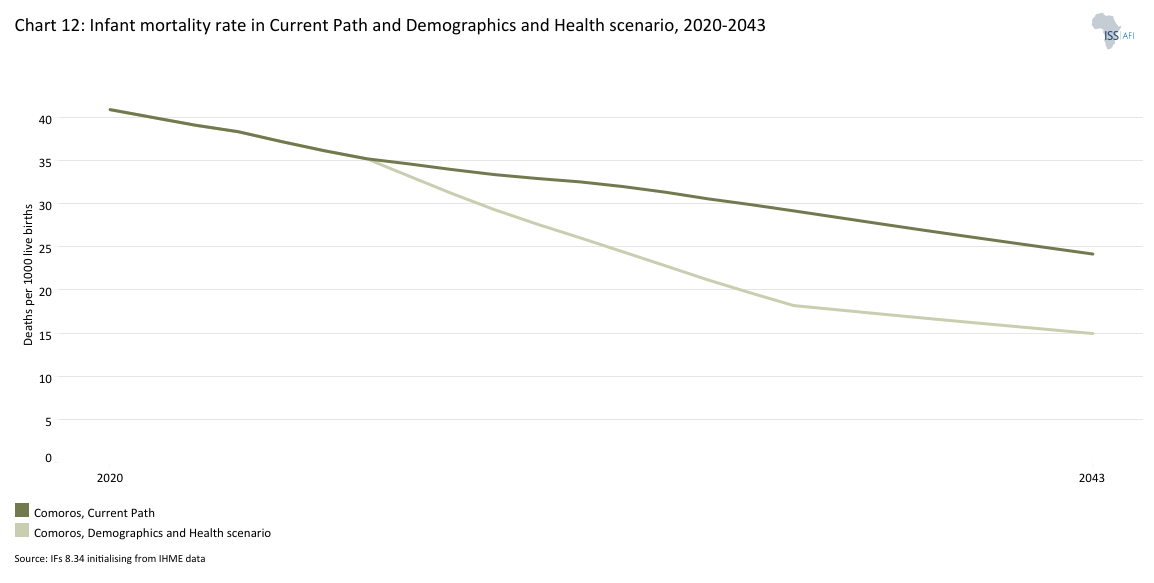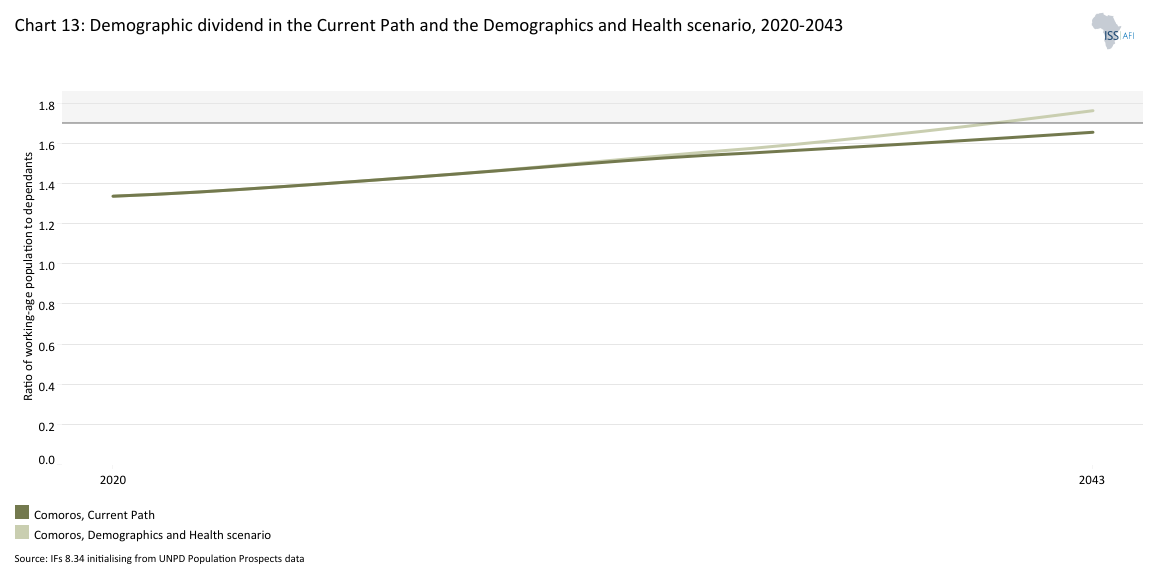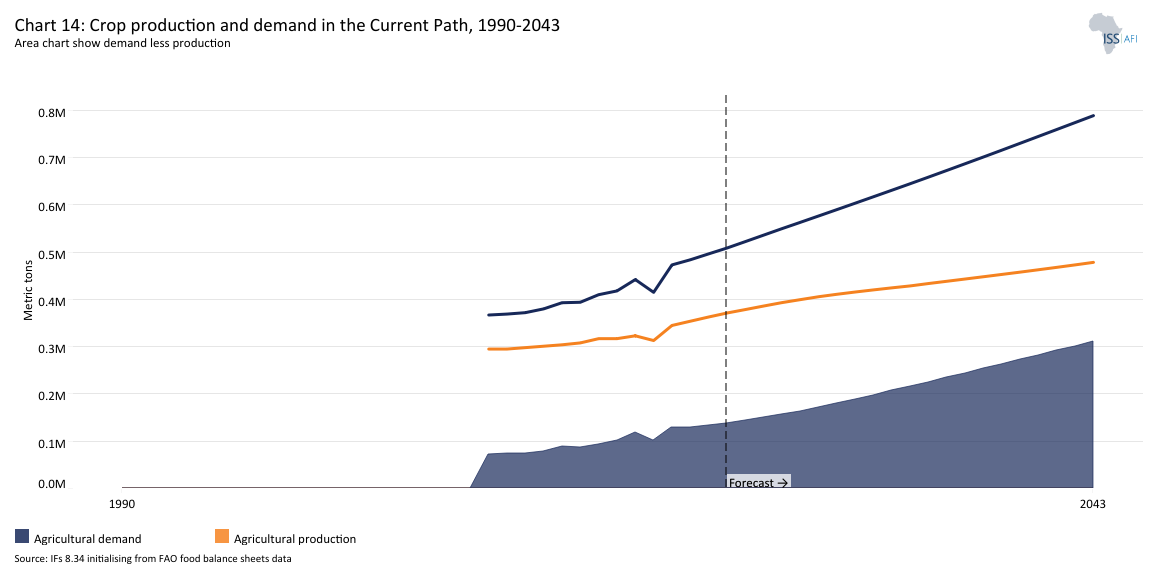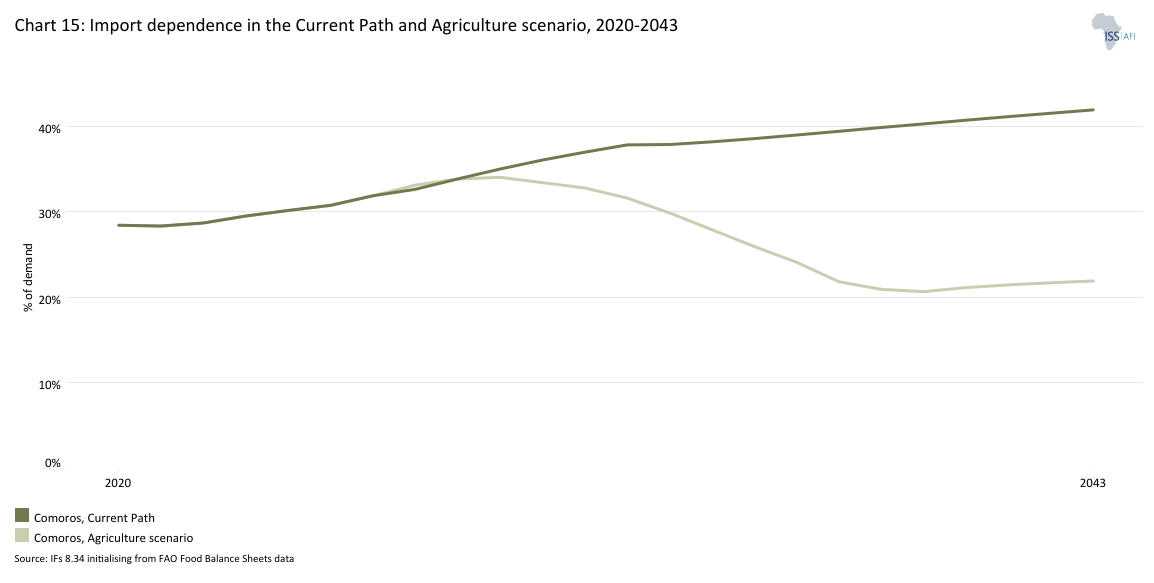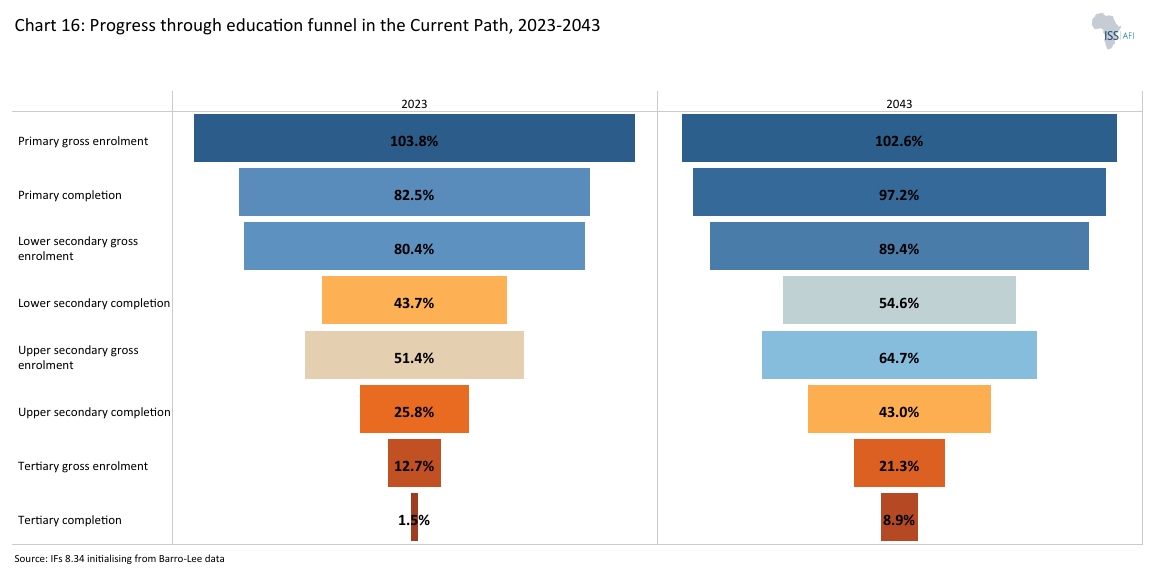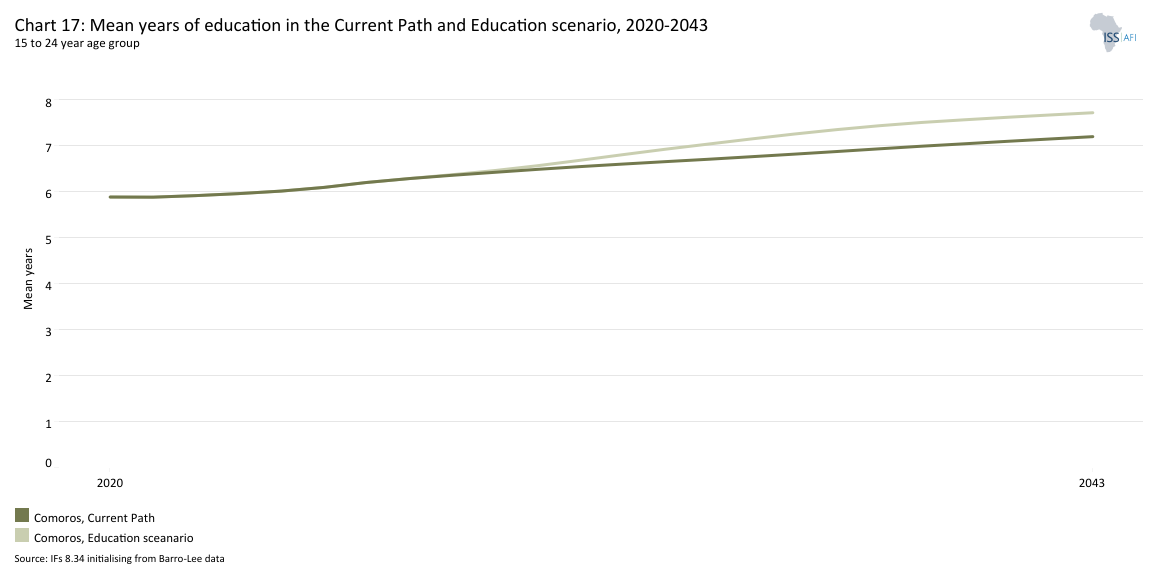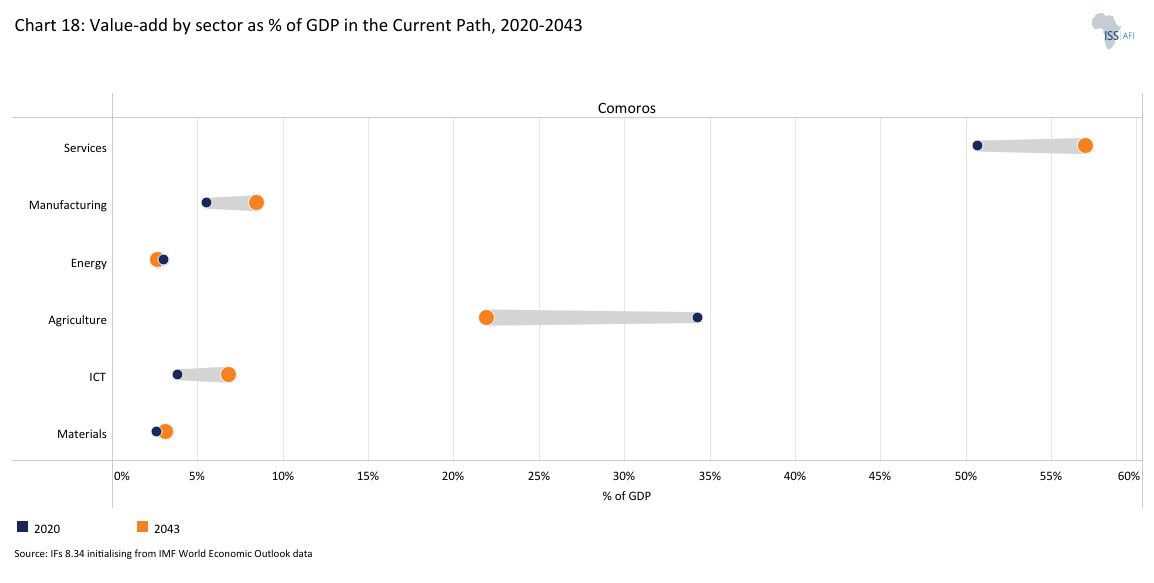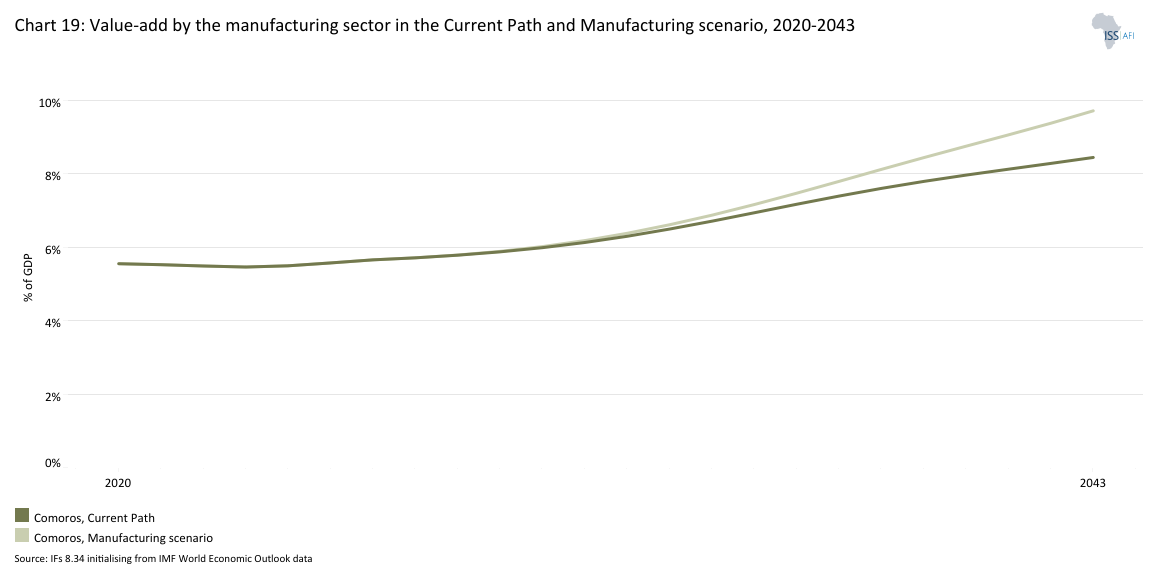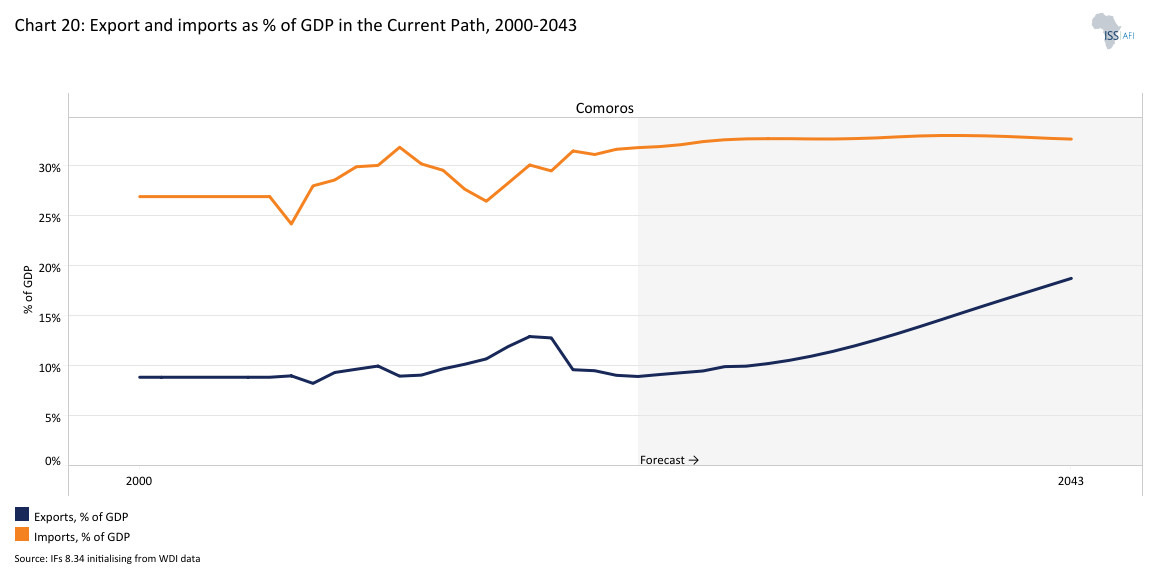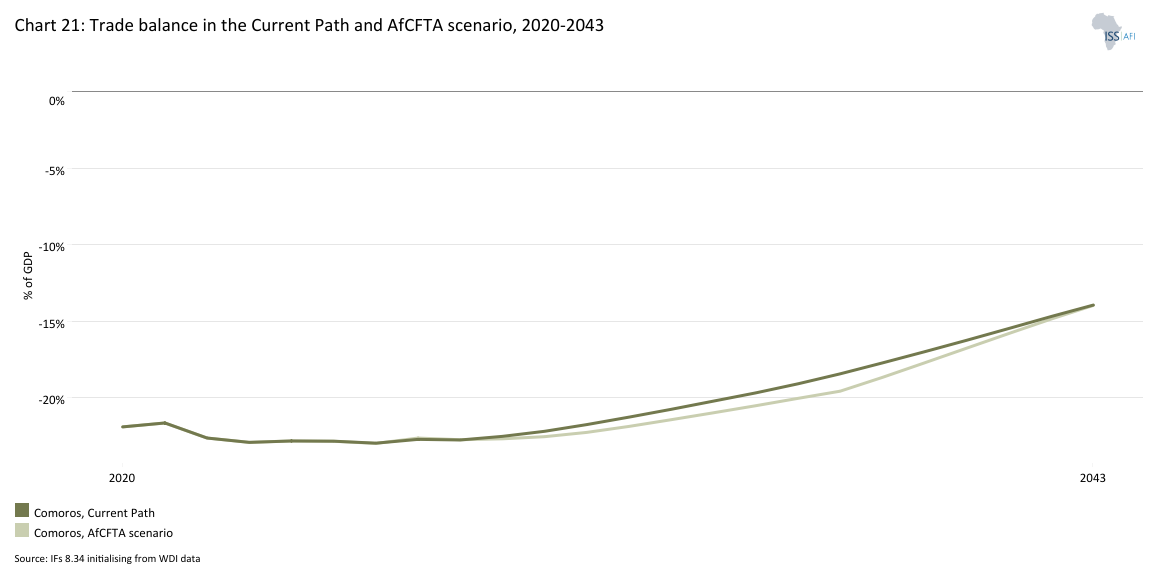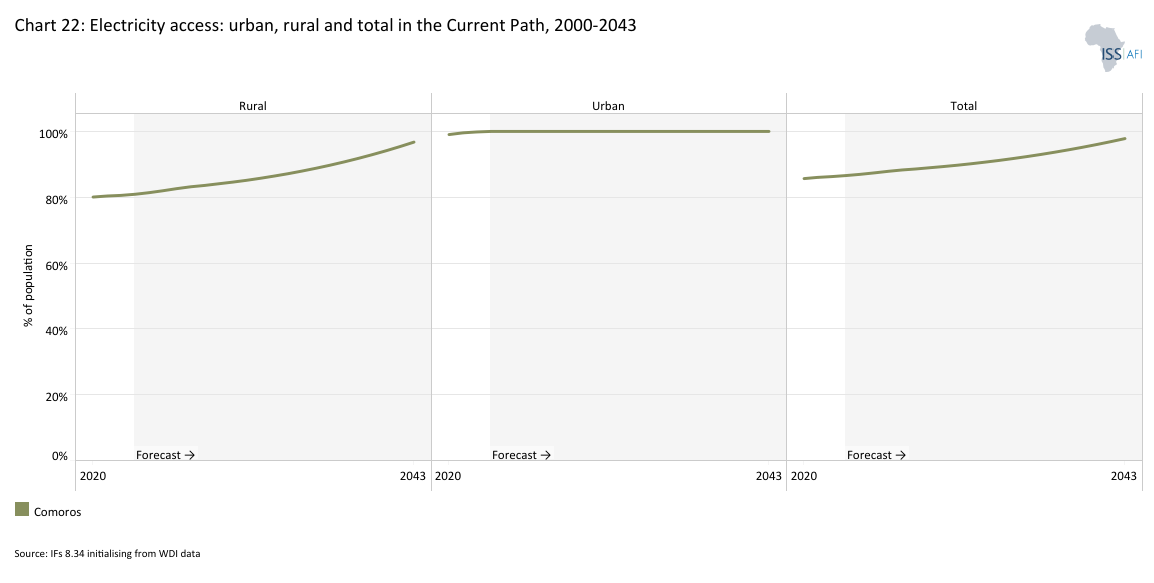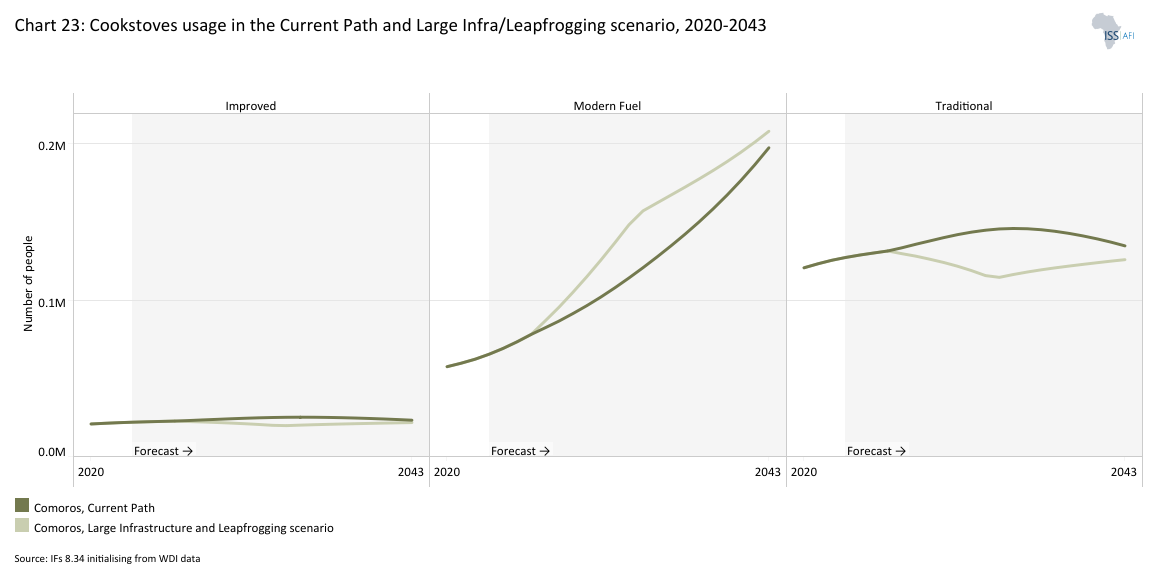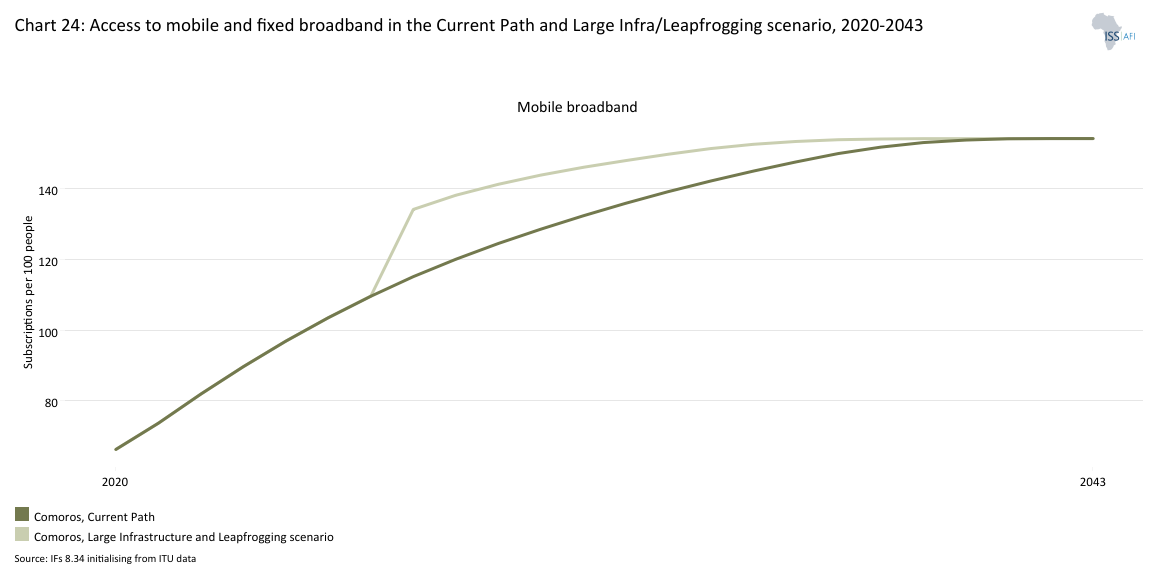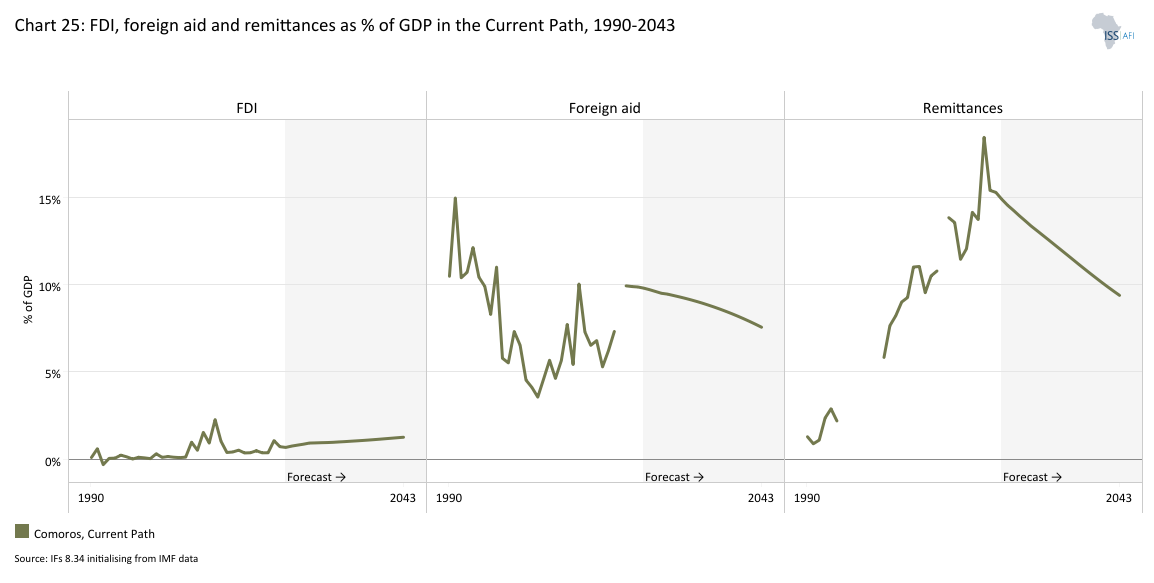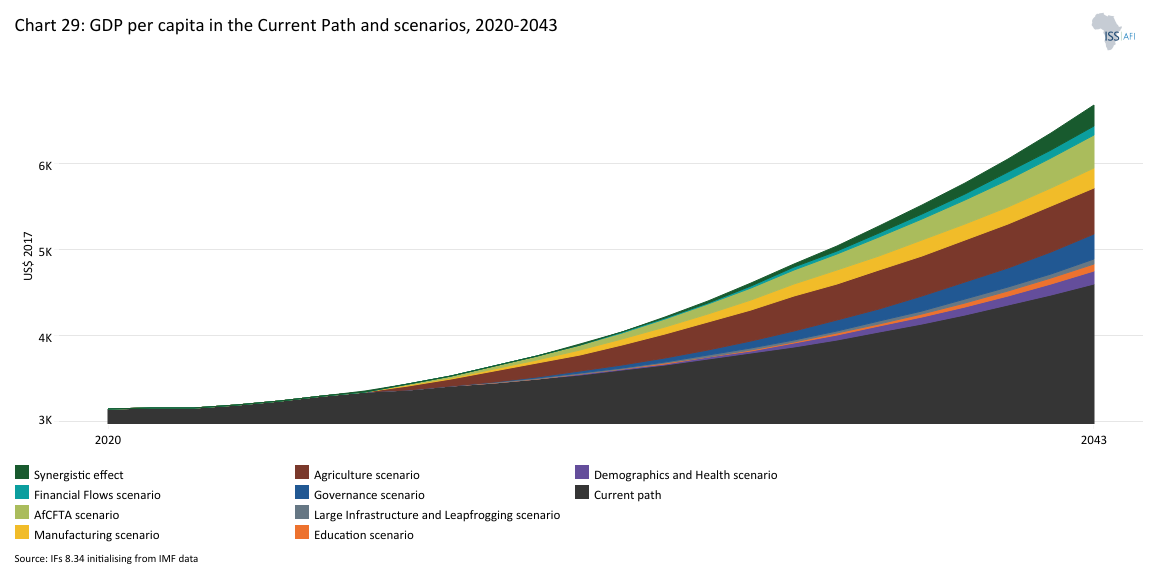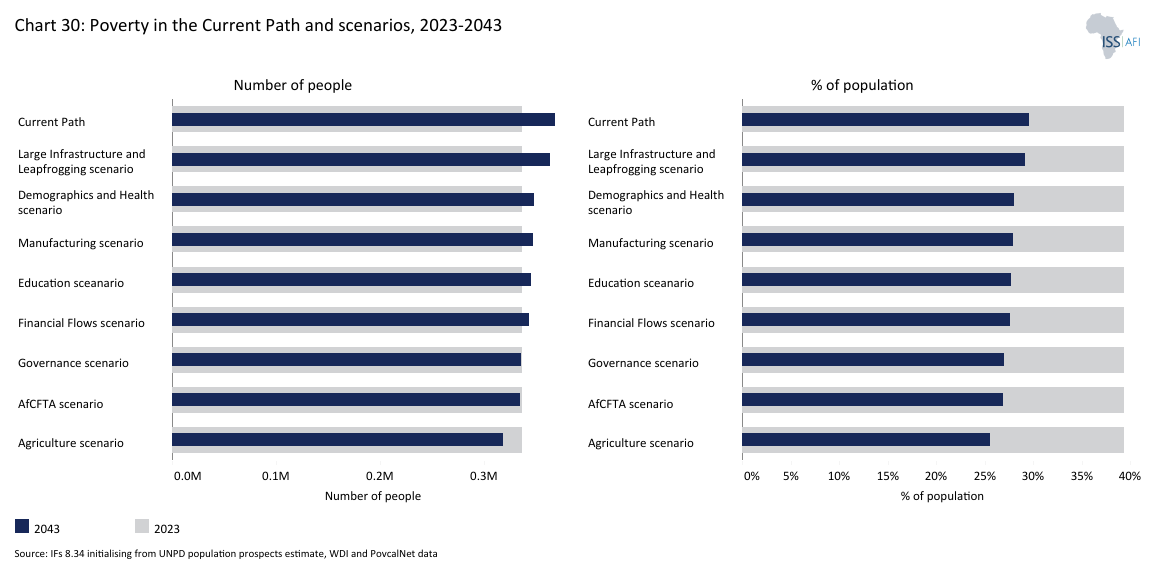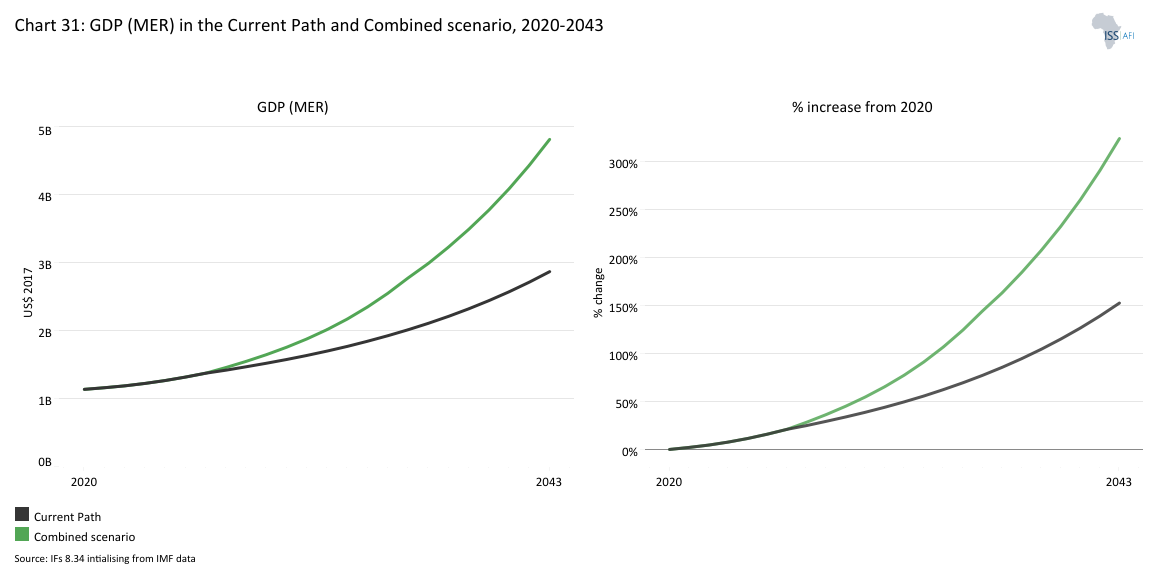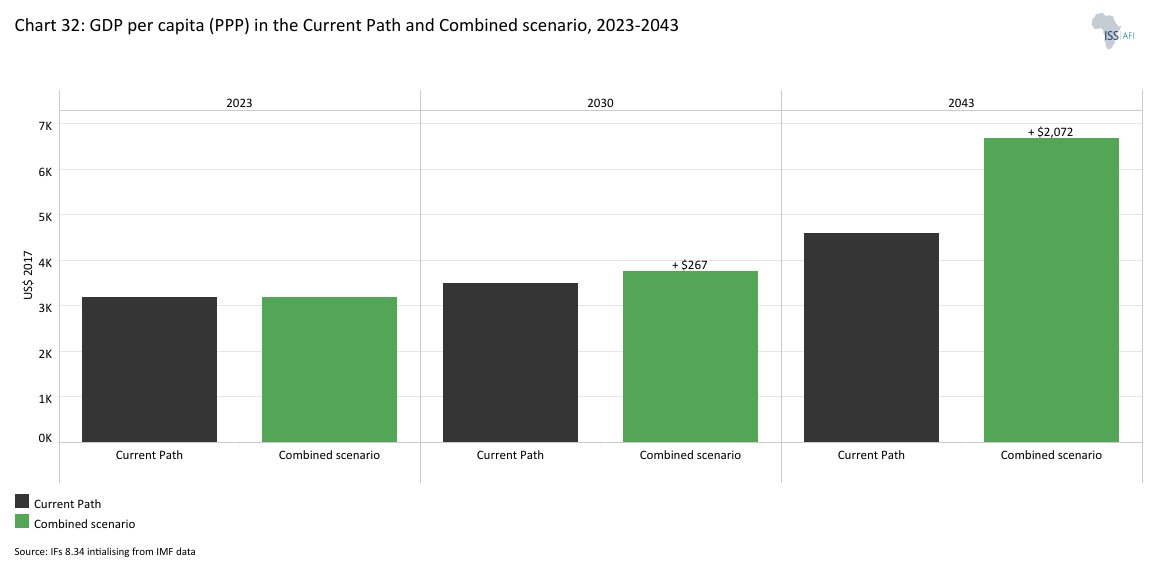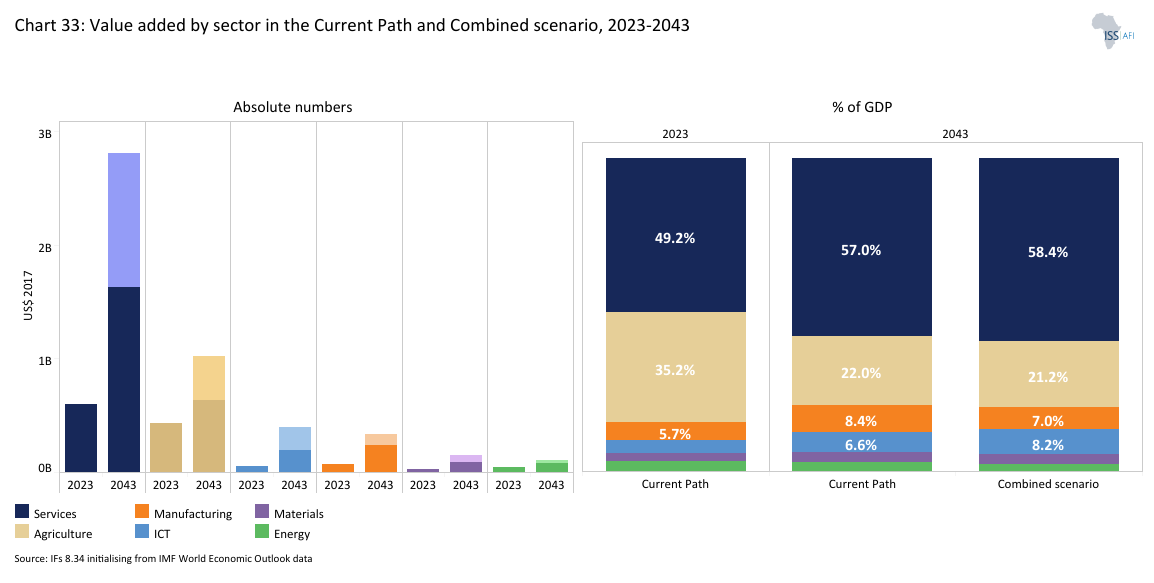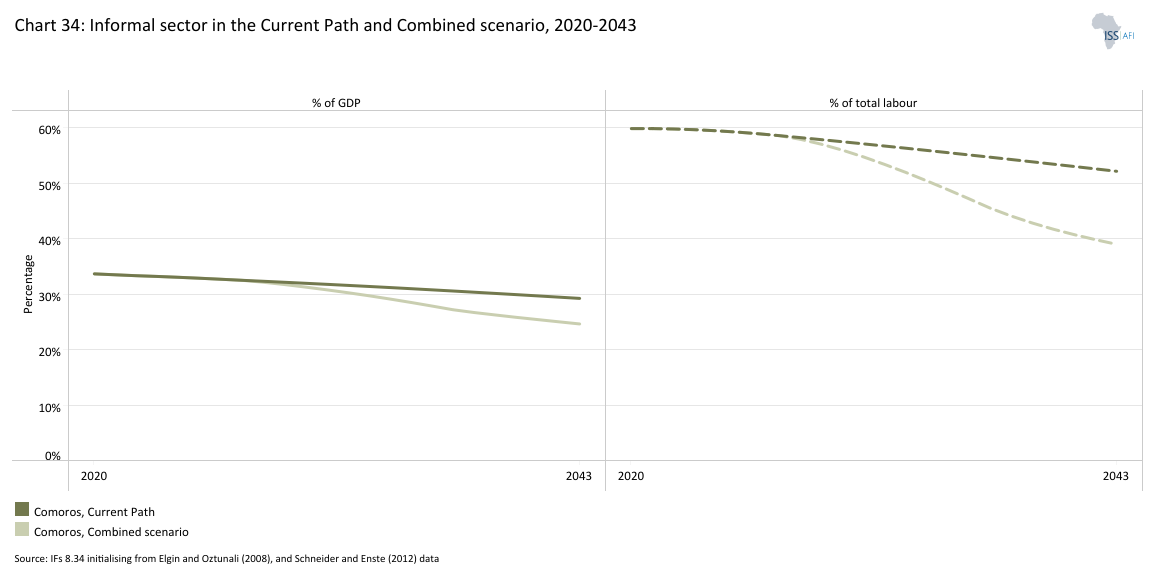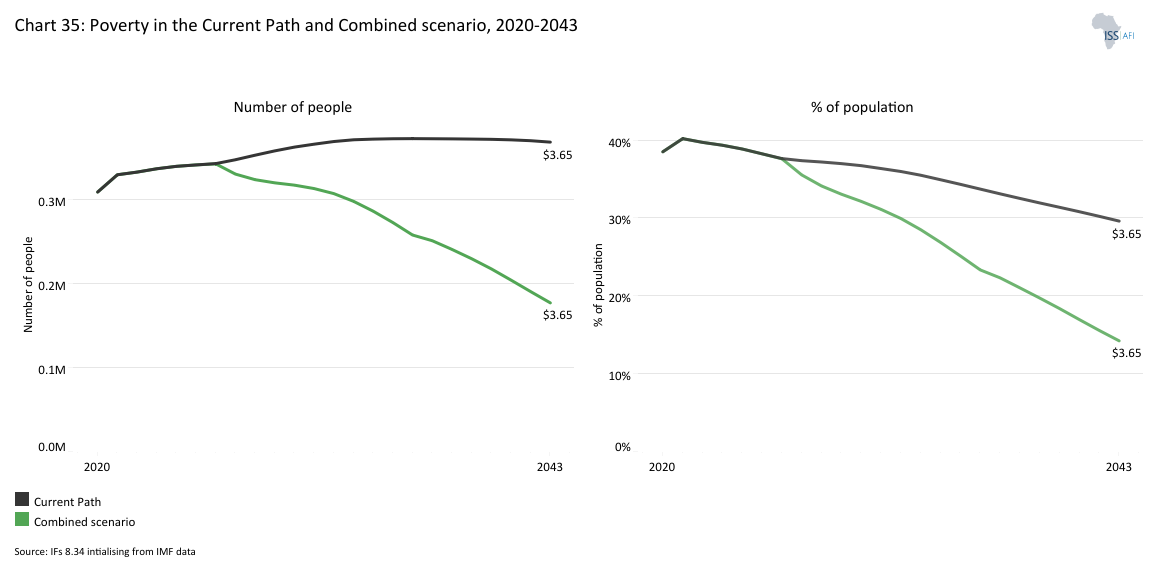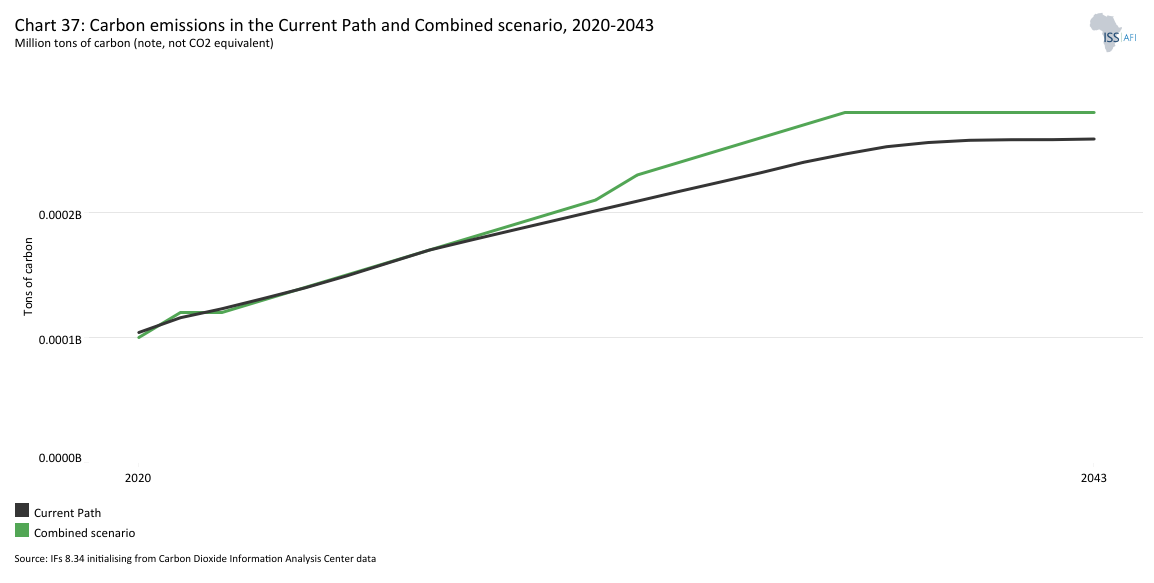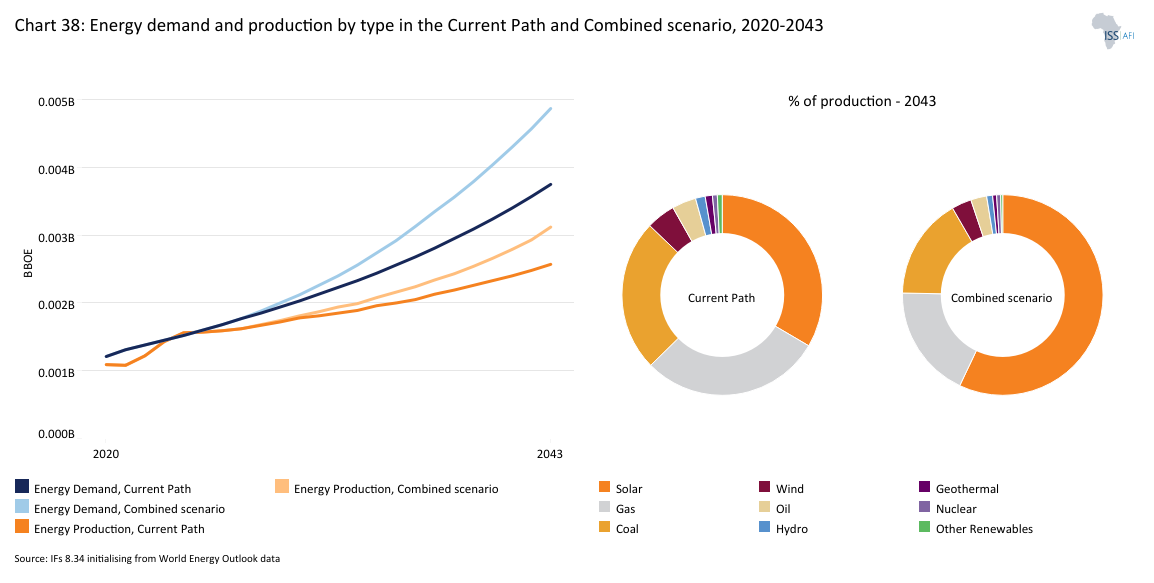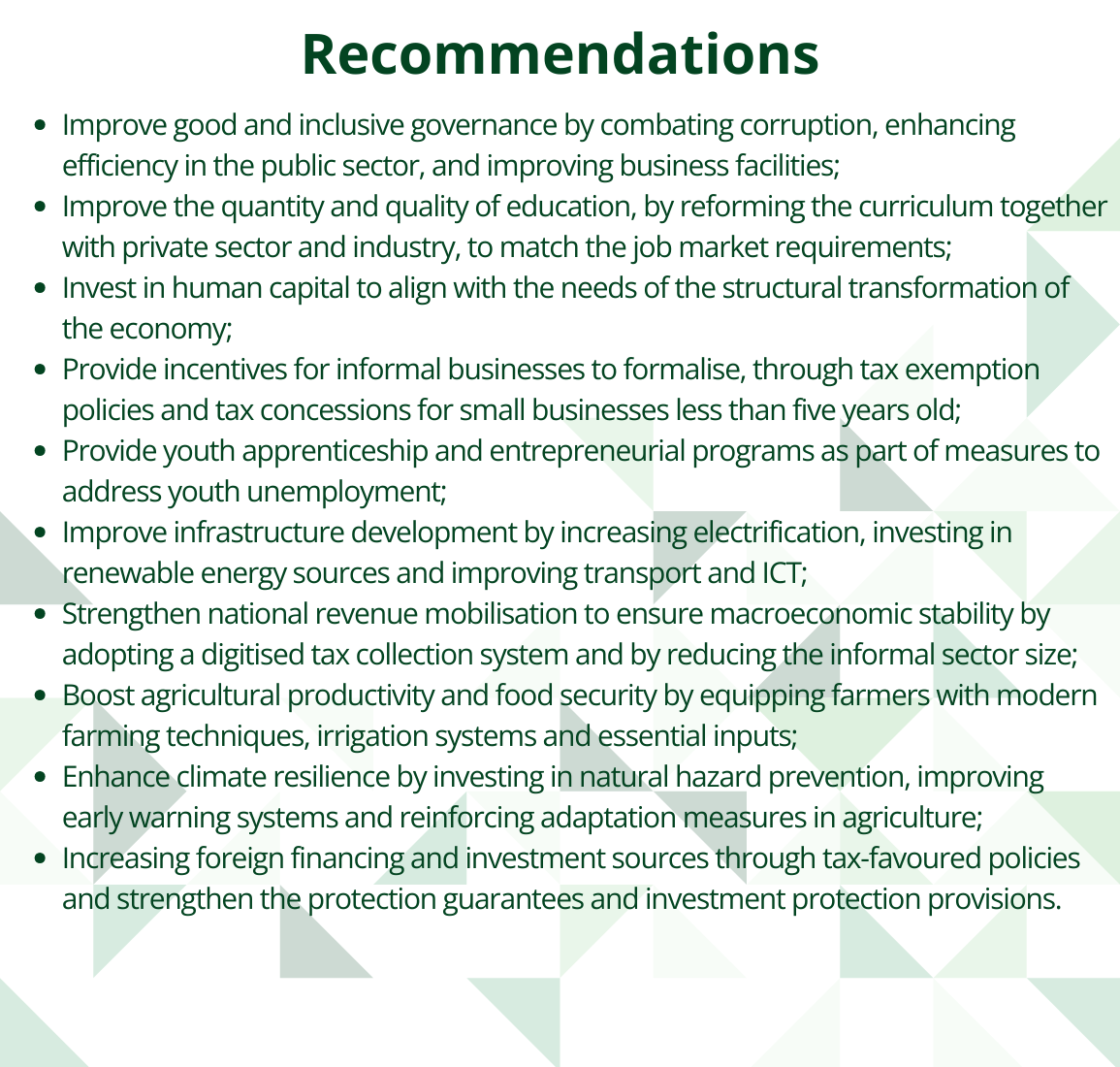 Comoros
Comoros
Feedback welcome
Our aim is to use the best data to inform our analysis. See our Technical page for information on the IFs forecasting platform. We appreciate your help and references for improvements via our feedback form.
This page asseses Comoros' current and projected future development, examining various sectoral scenarios and their potential impacts on the country's growth. It explores eight individual sectoral scenarios that include education, governance, health and demographic, trade and infrastructure-related outcomes, and combines the impact of these eight scenarios for Comoros up to 2043 - the end of the third ten-year implementation plan for the African Union Agenda 2063. The analysis offers insights into policy actions that could enhance Comoros' developmental trajectory.
For more information about the International Futures modelling platform we use to develop the various scenarios, please see About this Site.
Summary
We begin this page with an introductory assessment of the country’s context by looking at current population distribution, social structure, climate and topography.
- Comoros was one of the most recent African countries to become independent, in 1975. Comoros is located at the entrance to the Mozambique Channel, between Madagascar and the east coast of Africa. The country has a total surface area of 2 236 km2, made up of four islands: Ngazidja (Grande Comore), Ndzouani (Anjouan), Mwali (Mohéli) and Maoré (Mayotte, under French administration). The total population of Comoros in 2023 is estimated at 855 480, with a median age of about 21.24 years and a fertility rate of around 3.92 births per woman. Nearly 70% of its population lives in rural areas, where the traditional lifestyle dominates, characterised by limited access to healthcare, education and strong dependence on subsistence farming.
This section is followed by an analysis of the Current Path for Comoros, which informs the country’s likely current development trajectory to 2043. It is based on current geopolitical trends and assumes that no major shocks would occur in a ‘business-as-usual’ future.
- GDP per capita in Comoros has improved slightly over three decades. GDP per capita (PPP, constant 2017 dollars) in Comoros was US$2 923 in 1990. In 2023, Comoros' GDP per capita reached US$3 193 (compared with US$6 103 for lower-middle-income African countries) - a growth rate of almost 9.3% compared with 1990 and equivalent to 20% of the world average. These GDP per capita figures have made Comoros a lower-middle-income country in 2019, as classified by the World Bank. Despite this, poverty and inequality continue to be a major concern in Comoros.
- Like many lower-middle-income countries in Africa, poverty in Comoros is widespread. Comoros is the fourth poorest lower-middle-income country in Africa. In 2023, 39.3% of the population lived below the poverty line of US$3.65, far below the average of 45.6% for lower-middle-income countries in Africa. The government's commitment to reduce poverty is expected to help Comoros to reduce its poverty rate to 9.5% by 2043.
- In 2023, Comoros’ Gini coefficient was 0.44 compared to the average of 0.38 of the lower-middle-income countries in Africa. This makes Comoros the least unequal country among the lower-middle-income countries. On the Current Path, income inequality in Comoros will remain at the same level across the forecast horizon (around 0.4). Such a situation seems to be further exacerbated by the informal sector, which limits the government's ability to mobilise the tax revenues necessary to finance public policies, especially social policies.
- Between 1990 and 2023, informal sector contribution to GDP increased from 25.1% of GDP to almost 33.1%, an increase of 8.5 percentage points (in value of US$ 0.2 billion). The informal economy is a major employer in Comoros, employing about 60% of the Comorian workforce. Out of this, women constitute 89.54% and men 42.0%. On the Current Path, the size of the informal sector is forecast to modestly decline from 33.1% in 2023 to 29.2 % of GDP by 2043. This will amount to an informal economy with a value of US$0.8 billion in 2043. However, the gap between Comoros and the average for lower-middle-income African countries will narrow significantly by 2043.
The next section compares progress on the Current Path with eight sectoral scenarios. These are Demographics and Health; Agriculture; Education; Manufacturing; the African Continental Free Trade Area (AfCFTA); Large Infrastructure and Leapfrogging; Financial Flows; and Governance. Each scenario is benchmarked to present an ambitious but reasonable aspiration in that sector.
- The implementation of the Demographics and Health scenario will accelerate the demographic transition in Comoros. In the Demographic scenario, the ratio of working-age people to dependants will increase much quicker than in the Current Path as more people enter the working-age group compared to dependants. In the Demographics and Health scenario, a rate of 1.7 working-age persons to dependants is expected in 2041 for Comoros - at which point the country will enter a potential demographic window of opportunity, provided other supporting conditions are in place. The Demographics and Health scenario will reduce Comoros’ infant mortality rate to and 14.9 deaths per 1 000 births by 2043. This will be 9.2 fewer deaths than in the Current Path.
- In the Agriculture scenario, yield per hectare will increase to 0.8 million metric tons by 2043 — a 12.5% improvement compared to the projections of the Current Path. The improvement in yields will lead to an improvement in total agricultural production. In the Agriculture scenario, total crop production will increase to 741 700 tons, almost 202 310 metric tons, or 37.5%, more than the Current Path by 2043. By 2043, crop production in Comoros will rise by 41.5% over the Current Path to 676 730 tons in the Agriculture scenario by 2043. The projected increases in crop production in the Agriculture scenario reduce the import dependency of crops in the country compared to the Current Path. By 2043, the net import of crops will decline to 17.9% of demand in the Agriculture scenario, compared with 40% in the Current Path.
- In the Education scenario, the mean years of adult education will rise to 6.6 years in 2030 and 7.7 years by 2043. At this rate, it will be 0.6 years more than in the Current Path by 2043. The Education scenario further increases average test scores for primary students to 41.8% in 2043, compared to the Current Path of 36.7 in the same period. At the secondary level, the average test scores for students in Comoros will rise to 49% in 2043 more than the Current Path and the average of lower-middle-income countries in Africa.
- Projections show that added value could reach nearly US$0.2 billion by 2043. In the Manufacturing scenario, Comoros makes slight progress in industrialisation compared to the Current Path. By 2043 the share of the manufacturing sector in GDP is about 9.7% (US$0.3 billion) — about 1.3 percentage points of GDP above the Current Path. It means that an aggressive manufacturing transition can add an extra US$0.1 billion to the economy of Comoros.
- The AfCFTA scenario would see Comoros' trade openness reach 56.2% of GDP - a slight improvement of 5.2 percentage points on the Current Path (51.4%) in 2043. However, the AfCFTA scenario appears to have no important impact on the balance of payments deficit in 2043.
- Based on the Large Infrastructure and Leapfrogging scenario, it is projected that 94% and 100% of Comorians will have access to electricity by 2030 and 2043, respectively. Also, all Comorians living in urban areas will have access to electricity in the scenario, and the portion of people with access to electricity in rural areas will improve to 100% by 2043 in the scenario instead of 96.7% in the Current Path. 58.3% of households in Comoros will use modern fuel for cooking in the Large Infrastructure and Leapfrogging scenario in 2043. This figure will be lower than the average for the country’s income-group peers at 70%, but far higher than the 39.7% in the Current Path by 2043.
- The Financial Flows scenario has a marginal impact on government revenue in Comoros. In this scenario, government revenue will rise to US$694.6 million in 2043, representing 23.2% of GDP above the average of 21.4% for lower-middle-income countries in Africa in the same year. Compared to the Current Path, the Financial Flows scenario will improve Comoros' government revenues by barely an extra US$46.9 million in 2043.
- Comoros faces several governance challenges that have impacted its development. Key governance challenges include governance capacity , governance inclusion, governance effectiveness and weak institutions. Comoros’ score on the composite governance index of 0.43 in 2023 was 17.1% lower than the average for lower-middle-income countries in Africa. In the Governance scenario, Comoros' score on the composite governance index will improve to 0.55, which is about 17.0% above the Current Path by 2043.
In the fourth section, we compare the impact of each of these eight sectoral scenarios with one another and subsequently with a Combined scenario (the integrated effect of all eight scenarios). In our forecasts, we measure progress on various dimensions such as economic size (in market exchange rates), gross domestic product per capita (in purchasing power parity), extreme poverty, carbon emissions, the changes in the structure of the economy, and selected sectoral dimensions such as progress with mean years of education, life expectancy, the Gini coefficient or reductions in mortality rates.
- All the sectoral scenarios contribute to GDP per capita (PPP) in Comoros. However, the scenario with the greatest impact on GDP per capita by 2043 is the Agriculture scenario, followed by the Governance and Manufacturing scenarios. In the Agriculture scenario, Comoros’ GDP per capita will witness an increase of US$541 (or 12%) more than the Current Path. The Governance and Manufacturing scenarios further raise GDP per capita by an additional US$289 and US$226 by 2043.
- The Agriculture scenario also has the largest potential to reduce extreme poverty, followed by the Governance, Manufacturing and Education scenarios. The Agriculture scenario has the potential to reduce extreme poverty in Comoros by an additional 49 793 people compared to the 2043 Current Path. Similarly, Governance, Manufacturing and Education can lift about 32 400, 22 400 and 22 400 people out of extreme poverty, respectively.
- In the Combined scenario, the GDP of Comoros will reach US$4 801 and exceed the Current Path (US$2 865 million) in 2043. Indeed, the Combined scenario will increase the size of the economy by an additional US$1 936 million by 2043 — an increase of 67.6% compared to the Current Path. Thus, the economy will grow at an average of 8.5% compared to the 5.6% economic growth in the Current Path. Similarly, in the Combined scenario, the GDP per capita for Comoros will increase to US$6 674 by 2043. This will be US$2 072 higher than the projection of US$4 602 on the Current Path.
- With the Combined scenario, the size of the informal sector in Comoros will decline to 24.6% of GDP although its absolute value will rise to US$1.2 billion in 2043. At this rate, the contribution of the informal economy will be lower than the 29.2% (valued at US$0.8 billion) on the Current Path. Likewise, by 2043, there will be about 298 600 fewer labour in the informal sector as compared to the Current Path. This will correspond to informal labour constituting 39% of total labour in the Combined scenario instead of 52.1% in the Current Path.
- In the Combined scenario, both the number and the proportion of poor people in Comoros will significantly decline. In the long term, extreme poverty in Comoros will be reduced further such that by 2043, only about 182 950 people in the country (14.6% of the population) will be living in extreme poverty. This means that, compared to the Current Path, almost 185 409 more people could be lifted out of poverty by 2043 in this scenario.
- In the Combined scenario, life expectancy will increase to 72.7 years in 2030 and 77.7 years by 2043, which will be 3.8 years more than the country’s Current Path in the same year. In both the Combined scenario and the Current Path, women will be expected to live about a third years longer than men by 2043.
- In the Combined scenario, the share of solar energy in total energy production in the country will rise significantly to constitute 58% of total energy production to become the leading contributor. This will be 19 percentage points more than its contribution to total energy production in the Current Path. The share of gas production estimated at 19.3% in 2043 in the scenario will also be above its contribution to total energy production in the Current Path. In the Combined scenario, the share of oil, wind and gas energy in total energy production in the country will be 3.2% of total energy production, below the Current Path by 2043.
- On the Current Path, carbon emissions from fossil fuels will increase 0.2 million tons in 2030 and to 0.3 million tons by 2043. In the Combined scenario, Comoros’ total carbon emissions will remain similar to the Current Path in the same year.
We end this page with a summarising conclusion offering key recommendations for decision-making.
Comoros suffers from structural fragility and its economic situation remains precarious, with a chronic inability to diversify. Agriculture is still based on three main products (vanilla, cloves and ylang-ylang), which account for 90% of exports.
Current analyses show that most macroeconomic indicators are improving over time. While it is true that economic growth is positive, and projections for the future tend to confirm this, it should be noted that it is not inclusive. Indeed, socio-political and structural indicators such as governance reveal a country plagued by corruption, a weak business climate and a human development index well below that of other African lower-middle-income countries. The precariousness of the country's transport infrastructure and its underdeveloped manufacturing sector further plunge the country into commercial weakness, limiting its ability to respond effectively to domestic and external demand. Scenario analysis of the various potential interventions in the eight key sectors could offer hope of improving the country's macroeconomic performance, if certain challenges are met. To put the country on the path to sustained growth and development, the Comorian government must implement decisive, targeted actions based on priority policies:
- Promote good and inclusive governance for inclusive development;
- Improve agricultural productivity and economic diversification for better agricultural yields and international competitiveness;
- Enhance climate risks management and support the development of green value chains;
- Facilitate private sector development;
- Improve the quantity and quality of human capital at all level;
- Boost the construction of transport, energy and technology infrastructures.
All charts for Comoros
- Chart 1: Political map of COMOROS
- Chart 2: Population structure in the Current Path, 1990–2043
- Chart 3: Population distribution map, 2023
- Chart 4: Urban and rural population in the Current Path, 1990-2043
- Chart 5: GDP (MER) and growth rate in the Current Path, 1990–2043
- Chart 6: Size of the informal economy in the Current Path, 2020-2043
- Chart 7: GDP per capita in Current Path, 1990–2043
- Chart 8: Extreme poverty in the Current Path, 2020–2043
- Chart 9: National Development Plan of Comoros.
- Chart 10: Relationship between Current Path and scenario
- Chart 11: Mortality distribution in the Current Path, 2023 and 2043
- Chart 12: Infant mortality rate in Current Path and Demographics and Health scenario, 2020–2043
- Chart 13: Demographic dividend in the Current Path and the Demographics and Health scenario, 2020–2043
- Chart 14: Crop production and demand in the Current Path, 1990-2043
- Chart 15: Import dependence in the Current Path and Agriculture scenario, 2020–2043
- Chart 16: Progress through the education funnel in the Current Path, 2023 and 2043
- Chart 17: Mean years of education in the Current Path and Education scenario, 2020–2043
- Chart 18: Value-add by sector as % of GDP in the Current Path, 2023 and 2043
- Chart 19: Value-add by the manufacturing sector in the Current Path and Manufacturing scenario, 2023–2043
- Chart 20: Exports and imports as % of GDP in the Current Path, 2000-2043
- Chart 21: Trade balance in the Current Path and AfCFTA scenario, 2023–2043
- Chart 22: Electricity access: urban, rural and total in the Current Path, 2000-2043
- Chart 23: Cookstove usage in the Current Path and Large Infra/Leapfrogging scenario, 2023–2043
- Chart 24: Access to mobile and fixed broadband in the Current Path and the Large Infra/Leapfrogging scenario, 2023–2043
- Chart 25: FDI, foreign aid and remittances as % of GDP in the Current Path, 1990-2043
- Chart 26: Government revenue in the Current Path and Financial Flows scenario, 2020–2043
- Chart 27: Government effectiveness score in the Current Path, 2002-2043
- Chart 28: Composite governance index in the Current Path and Governance scenario, 2023 and 2043
- Chart 29: GDP per capita in the Current Path and scenarios, 2023–2043
- Chart 30: Poverty in the Current Path and scenarios, 2023–2043
- Chart 31: GDP (MER) in the Current Path and Combined scenario, 2023–2043
- Chart 32: GDP per capita in the Current Path and Combined scenario, 2023-2043
- Chart 33: Value added by sector in the Current Path and Combined scenario, 2023 and 2043
- Chart 34: Informal sector in the Current Path and Combined scenario, 2023–2043
- Chart 35: Poverty in the Current Path and Combined scenario, 2023 and 2043
- Chart 36: Life expectancy in the Current Path and Combined scenario, 2023–2043
- Chart 37: Carbon emissions in the Current Path and Combined scenario, 2023–2043
- Chart 38: Energy demand and production by type in the Current Path and Combined scenario, 2023-2043
- Chart 39: Policy recommendations
Chart 1 is a political map of Comoros.
Comoros is located at the entrance to the Mozambique Channel, between Madagascar and the east coast of Africa. The country has a total surface area of 2 236 km2, made up of four islands: Ngazidja (Grande Comore), Ndzouani (Anjouan), Mwali (Mohéli) and Maoré (Mayotte, under French administration). The capital city Moroni is located on the biggest island of Grande Comore (N’gazidja). The total population of Comoros in 2023 is estimated at 855 480. The country gained independence in 1975 after citizens voted for self-determination in a French-organised referendum in 1974.
The climate is tropical and characterised by two main seasons: Kashkasi (the hot, humid season marked by heavy rains and cyclones) and Kussi (the dry, cool season with north to north-westerly monsoon winds). The soil is of volcanic origin, with heavy rainfall especially during the Kashkasi season, which brings a wide variety of produce, such as tropical fruits, spices, aromatic crops, vegetables and cereals. The country’s location in the warm Indian Ocean exposes it to intense tropical storms and cyclones. Seven tropical cyclones in the past four decades have caused devastation, with Cyclone Kenneth affecting 345 000 people and wiping out 80% of crop production in 2019. Recovering from the 2019 devastation caused by Cyclone Kenneth was complicated with the onset of the COVID-19 pandemic in 2020 that affected the country’s tourism, service sector and export market of cash crops.
Comoros is a member of the Southern African Development Community (SADC), the Community of Sahel-Saharan States (CEN-SAD), the Common Market for Eastern and Southern Africa (COMESA) and, on 27 February 2024, Comoros joined the World Trade Organization (WTO). Comoros is one of 23 lower-middle-income countries in Africa, according to the World Bank’s income classification. Its economy is heavily reliant on subsistence farming and fishing while manufacturing is limited to the processing of agricultural products. Aid contributions from the EU heavily contribute to budgetary support.
While Comoros boasts great ecotourism potential due to its rich biodiversity and tropical climate, the country is paralysed by its turbulent political history. More than 15 successful, attempted and plotted coups d’état have taken place in the period after independence, severely hampering development. In 1990, democracy was established by President Djohar. This political system legitimised trade union associations. The numerous constitutional changes, both voluntary and involuntary, that Comoros has undergone have greatly contributed to its political fragility. However, since the last constitutional change in 2001, the country has constantly sought to turn into a true democracy. This desire is reflected in the country's numerous presidential and legislative elections. For instance, the Presidential elections of 2024 with the re-election of President Azali Assoumani for a third time after his previous election triumphs in 2016 and 2019 and his decade-long political absence.
The geographical isolation of the island state, its limited land resources, heavy agricultural subsistence reliance, political turmoil and the additional burden of climate change and natural hazards are all threatening the sustainable development of Comoros. Comoros’ development prospects are examined in more detail in the subsequent charts and sections.
Chart 2 presents the Current Path of the population structure, from 1990 to 2043.
The population of Comoros increased from 444 600 in 1990 to 855 480 in 2023, making it the country with the fifth-smallest population in Africa and 72nd in the world. The relatively smaller population is partly accounted for by the drop in fertility rates over the years. Total fertility rates have dropped the past three decades, down from 6.5 births per woman in 1990 to 3.9 in 2023, slightly above the 3.8 average of lower-middle-income Africa. In the Current Path, the population will reach 1.2 million people by 2043 — representing a 40% increase over the same period. The projected growth in population will place severe pressure on this small island state that is already battling high population densities and limited land (7.1 per person hectare of crop land, compared with 5.4 for lower-middle-income Africa in 2023). The drop in fertility rates will alter the age structure of the country with the median age expected to increase from 21.24 years in 2023 to 25.1 years by 2043.
Comorian population structure has not changed significantly since the 1990s. For instance, Comoros' population aged under 15 has fallen only from 41.1% of the population in 1990 to 37.7% in 2023. On the Current Path, this drop will continue to 2043, when the under-15 population is estimated to decline to 31.5% of the population. However, the working-age population (age 15–65) increased from 47.9% in 1990 to 57.8% of the population in 2023. In addition, the country has a small elderly dependent population. Comoros' population aged over 65 increased from 3.9% in 1990 to 4.4% of the population in 2023 and will reach nearly 6.1% of the population in 2043 — this figure implies an increase in life expectancy, from 69.5 years in 2023 to 73.9 years in 2043. This represents an increase of 5.1 years over the period.
The country's first demographic dividend is expected only after the forecast horizon, in 2043. The use of modern contraception by Comorian women remains low and in 2023 it was estimated at 20.5 % of fertile women. However, government policies to make modern contraceptives available to the Comorian population while offering high quality and equitable services and continuing to generate demand should help to accelerate the process of contraceptive use. It is estimated that by 2043, this rate of use could reach 34%.
Chart 3 presents a population distribution map for 2023.
Comoros is the third-smallest country in Africa with a geographic size of 1 862 km2. Its small land size makes it one of the most densely populated countries in Africa. In 2023, its population density of 4.6 people per hectare was the fourth highest in Africa and almost six times the average for lower-middle-income African countries. The population densities are expected to increase to 6.7 people per hectare in 2043, significantly above the average of 1.01 people per hectare for lower-middle-income Africa. This high population density puts intense pressure on natural resources, social amenities and the environment. The country's location and topography make it one of the most climate-vulnerable in the world, with 54.2% of the population living in high-risk areas. In fact, all three islands feature a rugged topography with steep peaks formed by volcanic activities. This places pressure on the coastal regions that have much higher population densities. Mount Karthala, one of the world’s most active volcanoes, is situated on Grande Comore and is surrounded by the protected Karthala forest, which limits development on its slopes and restricts available land for future development. Land pressure is one of the biggest constraints for development in Comoros. The population is unevenly distributed across the islands: Grande-Comore (1 148 km²) is the most populous with over 400 000 inhabitants, followed by Anjouan (424 km²) with 337 000 and Mohéli (290 km²) with 40 000.
Chart 4 presents the urban and rural population in the Current Path, from 1990 to 2043.
Comoros is a predominantly rural country with 70% of its population living in rural agglomerations/clusters throughout the three islands in 2023. This makes it the fourth most rural country among Africa’s lower-middle-income countries. In part, this is due to the dominance of the agriculture sector which constitutes over 40% of GDP and is source of employment to a significant proportion of the population.
Consequently, the urban population rose from 27% in 1990 to 30% in 2023. However, over 70% of the urban population engages in informal economic activities and lives in poor housing conditions.
On the Current Path, Comoros’ rural population will be around 66.8% by 2043 - a drop of 3.2 percentage points in 20 years. The reason for this drop in rural population lies mainly in poor living conditions in rural areas. The Food and Agriculture Organization (2022) and the Demographic, Health and Multiple Indicator Survey[1] (2012) point out that the rural exodus is the consequence of declining agricultural production, the concentration of public investment and economic activities in urban areas, lack of access to energy and the isolation of rural areas.
Chart 5 presents GDP in market exchange rates (MER) and growth rate in the Current Path, from 1990 to 2043.
Comoros has a very small economy largely due to its small population. Its GDP, measured in market exchange rate, is measuring only US$1.2 billion in 2023. The economy is heavily reliant on subsistence farming and fishing while manufacturing is limited to the processing of agricultural products. As a result, economic growth is volatile, affected by natural and international shocks. Indeed, shortly before the COVID-19 pandemic cyclone Kenneth saw growth rates decline to 1.8% in 2019 followed by −0.3% in 2020 (due to the COVID-19 pandemic). However, the economy recovered slightly in 2021, with growth of 2.4%, and this positive trend continued through 2023, with growth of 3%.
This overall slow growth can be partly explained by structural factors, such as weak institutions, a small population, limited human and physical capital and geographical remoteness, all of which have a negative impact on private sector development. For instance, the country boasts significant ecotourism potential but its turbulent political history, the lack of connectivity between the three islands and limited transportation routes severely hamper its potential.
Households are also receiving a great deal of support from remittances (estimated at nearly 17% of GDP) to support their consumption and thus boost domestic demand. Furthermore, World Bank points out that this economic dynamism in Comoros is due to an increase in private consumption, driven by “grands mariages” and vigorous tourism, and a rise in investment, particularly in public infrastructure, as with the construction of the El Maarouf hospital and the Galawa hotel.
Due to the stability of commodity prices over the past two years, inflation has fallen from 12.4% in 2022 to 8.5% in 2023. In 2024, inflation fell to 3.7% on average - leading to an acceleration in private consumption. Budget deficit rose from 3.8% of GDP in 2022 to 4.3% in 2023, due to higher civil servant salaries, lower grants and expenses related to the country's presidency of the African Union, despite higher budget revenues (up 12%). The debt/GDP ratio was 38.2% in 2023. However, the risk of debt distress is high, due to the limited repayment capacity of non-concessional loans.
On the Current Path, this breath of oxygen is expected to boost the Comoros economy and will more than double to US$2 986 billion by 2043 - an increase of US$1.73 billion over the next two decades.
Chart 6 presents the size of the informal economy as per cent of GDP and per cent of total labour (non-agriculture), from 2020 to 2043. The data in our modelling are largely estimates and therefore may differ from other sources.
The informal economy comprises activities that have market value and would add to tax revenue and GDP if they were recorded. According to the International Labour Organization (ILO), informal employment is often associated with income insecurity, unsafe work conditions and limited access to the rights and benefits accorded to the formal sector. Countries with high informality have a host of development challenges such as higher poverty, lower per capita incomes, greater inequality and weaker productivity investment, among others.
Like in most African economies, the informal sector is a significant part of the Comorian economy, and has grown steadily over time. Between 1990 and 2023, its contribution to GDP increased from 25.1% of GDP to almost 33.1%, an increase of 8.5 percentage points (in value of US$ 0.2 billion). The informal economy is a major employer in Comoros, employing about 60% of the Comorian workforce. Out of this, women constitute 89.5%. This employment pattern is partly linked to the Comorian economy's heavy dependence on subsistence farming. Also, the Comorian people's low level of education, which limits their ability to understand tax and social security procedures and, in particular, the poor quality of the institutional environment and business environment limit opportunities for the creation of formal small businesses.
According to the World Bank, informal firms are small and operate in low-productivity sectors with low-skilled workers. Most informal production units are located in rural areas, mainly concentrated on the islands of Ngazidja (except Moroni) and Ndzouani, and are mainly involved in agriculture, followed by industry and commerce. On the other hand, informality is fairly low in the services sector. In Comoros, around 80% of informal production units have only one self-employed worker and almost 95% operate with two or fewer employees. More than half of workers in the informal sector have not completed basic education, and less than 7% have been able to study beyond primary school.
On the Current Path, the size of the informal sector will modestly decline from 33.1% in 2023 to 29.2% of GDP by 2043. This will amounts to an informal economy with a value of US$ 800 million in 2043. However, the gap between Comoros and the average for lower-middle-income African countries will narrow significantly by 2043.
Chart 7 presents GDP per capita in the Current Path, from 1990 to 2043, compared with the average for the Africa income group.
Despite its limitations, GDP per capita is generally used to measure the standard of living and is the most applied and accepted indicator to compare welfare among countries. Using the purchasing power parity (PPP) measure for this analysis, Comoros' GDP per capita has improved modestly over the last thirty years. Comorian GDP per capita of US$3 193 in 2023 is the second-lowest GDP per capita among the lower-middle-income countries in Africa, and it is less than half the group average of US$6 143 for lower-middle-income countries in Africa. This figure represents an improvement of a paltry 8.5% from the US$2 923 it recorded in 1990.
This modest improvement has contributed to increased inequality and poverty, a major challenge faced by Comoros. The slow growth in GDP per capita is mainly attributed to a set of structural constraints, such as the quality of governance, the country's vulnerability to external shocks (particularly natural disasters), the impacts of climate change (drought, rising sea levels, etc.), the small size of its domestic market (low population which limits internal demand) and the quality of its redistributive policies. Comoros' GDP per capita is forecast to rise steadily to US$ 4 602 in 2043. However, major challenges facing the country include fostering private investment initiatives, promoting productivity growth (especially of labour and capital), including improving the macroeconomic environment - ensuring effective and efficient fiscal policy, strengthening tax revenue mobilisation mechanisms and creating an economic environment that fosters enhanced investor protection and the enforcement of the rule of law.
Chart 8 presents the rate and numbers of extremely poor people in the Current Path from 2020 to 2043.
In 2022, the World Bank updated the poverty lines to 2017 constant dollar values as follows:
- The previous US$1.90 extreme poverty line is now set at US$2.15, also for use with low-income countries.
- US$3.65 for lower-middle-income countries, now US$3.65 in 2017 values.
- US$5.50 for upper-middle-income countries, now US$6.85 in 2017 values.
- US$22.70 for high-income countries. The Bank has not yet announced the new poverty line in 2017 US$ prices for high-income countries.
Monetary poverty only tells part of the story, however. In addition, the global Multidimensional Poverty Index (MPI) measures acute multidimensional poverty by measuring each person’s overlapping deprivations across 10 indicators in three equally weighted dimensions: health, education and standard of living. The MPI complements the international US$2.15 a day poverty rate by identifying who is multi dimensionally poor and also shows the composition of multidimensional poverty. The headcount or incidence of multidimensional poverty is often several percentage points higher than that of monetary poverty. This implies that individuals living above the monetary poverty line may still suffer deprivations in health, education and/or standard of living.
Theoretically, poverty exists when part of the population is unable, by society's standards, to attain a level of well-being considered to be a minimum requirement. The minimum level of well-being can be defined by estimating one or more poverty lines. The definition of this poverty line is generally a function of consumption patterns and the cost of living in the country's main regions or cities. Like in many lower-middle-income countries in Africa, poverty in Comoros is widespread. Comoros is the fourth-poorest lower-middle-income country in Africa, with a 27.1% human poverty index. This figure represents a marginal change from 2023 (when the index was 27.6%), primarily attributed to limited growth and a lack of structural change.
By utilising the lower-middle-income poverty line of US$3.65 a day (in 2017 PPP), in 2023, 336 203 Comorians, representing 39.3% of the population, lived below this poverty line which is below the average of 45.6% for lower-middle-income countries in Africa. The Comoros government has implemented further strategies to reduce poverty and inequality, notably through the “Plan Comores Emergent”.
Despite these efforts, Comoros continues to face challenges in economic growth, which are marked by a poor business environment and difficulties in accessing finance. Informal employment and low productivity dominate the labour market, which does not really help to increase household income levels. In addition, the weight of the informal sector limits the mobilisation of the tax revenues needed to increase basic services. Furthermore, inadequate levels of human and physical capital and resource misallocation have impeded growth in the tourism and fisheries sectors despite their significant potential for job creation. All these constraints also exacerbate the dynamics of Comorian non-monetary poverty as the Human Development Index (HDI)[2].
Comoros’ HDI score of 0.59 in 2022 ranks 152 out of 193 countries globally, a slight drop compared to the 0.58 it recorded in 2021. The global Multidimensional Poverty Index (MPI) also measures acute multidimensional poverty by measuring each person’s overlapping deprivations across 10 indicators in three equally weighted dimensions: health, education and standard of living. According to the latest data, the MPI for Comoros in 2023 was 0.18. This indicates that a significant portion of the population in Comoros experiences multidimensional poverty, with an "intensity of deprivations" among the poor population at 48.5%. In Comoros, 41.1% of the rural population is poor, and 79% of the poor live in rural areas.
On the Current Path, this government engagement is expected to help the country reduce its poverty rate to 29.5% by 2043.
Chart 9 depicts the National Development Plan of Comoros.
Comoros has had several strategic documents to guide the country's socio-economic and political development policy. These include the Country Strategy Paper (CSP) 2021-2025, which is aligned with the Emerging Comoros Plan 2030 and the Strategy for Accelerated Growth and Sustainable Development (SCA2D) 2018-2021, with the aim of facilitating the structural transformation of the Comorian economy. The aim is to achieve the following objectives:
- Achieving sustainable, strong, inclusive and equitable economic growth;
- Alleviating poverty;
- Improving the well-being of the population;
- Strengthening the resilience capacities of vulnerable groups;
- Promoting more productive and resilient agricultural systems;
- Integrating the resilience of rural communities.
The first is “Plan Comores Émergent à l'horizon 2030” associated with the former “Document de Stratégie de Croissance Accélérée et de Développement Durable” (SCA2D) 2018-2021. The Plan Comores Émergent was drawn up to accelerate the process of structural transformation in order to make Comoros an emerging country by 2030.
The plan is based on five pillars and five catalysts. The strategic foundations for the structural transformation of the economy towards emergence are entitled:
- i) tourism and handicrafts, major assets for Comoros in the Indian Ocean;
- ii) a strong blue economy for Comoros;
iii) Comoros, a hub for financial and logistical services in the Indian Ocean;
- iv) modernised agriculture for food security;
- v) industrial niches to diversify the economy.
The catalysts, essential to the materialisation of the foundations of emergency are:
- a reformed and more stable political and institutional framework;
- upgraded infrastructure for a high-performance economy;
- human capital to prepare for the future;
- structural reforms for a competitive environment;
- Comoros, a player in the digital revolution.
The second is the Country Strategy Paper 2021-2025, drawn up in early 2021 - which sets out the country's medium-term objectives to achieve the “Plan Comores Émergent” (PCE) 2030. It aims to reduce fragility and strengthen the country's resilience in order to promote its structural transformation and emergence. To this end, it is based on a single priority area, namely the ‘Development of high-quality, sustainable basic infrastructure in the transport and energy sectors’.
The eight sectoral scenarios as well as their relationship to the Current Path and the Combined scenario are explained in the About Page. Chart 10 summarises the approach.
Chart 11 presents the mortality distribution in the Current Path for 2023 and 2043.
The Demographics and Health scenario envisions ambitious improvements in child and maternal mortality rates, enhanced access to modern contraception, and decreased mortality from communicable diseases (e.g., AIDS, diarrhoea, malaria, respiratory infections) and non-communicable diseases (e.g., diabetes), alongside advancements in safe water access and sanitation. This scenario assumes a swift demographic transition supported by heightened investments in health and water, sanitation, and hygiene (WaSH) infrastructure.
Visit the themes on Demographics and Health/WaSH for more detail on the scenario structure and interventions.
The health sector in Comoros has made significant progress in recent years, although a number of challenges remain. For example, through its “Programme d'appui au secteur de la santé aux Comores[1]” (PASCO), Comoros has seen a marked improvement in health indicators, particularly those relating to maternal and child health. PASCO has enabled the rehabilitation and construction of 22 health facilities on the three islands of Comoros and most recently the construction of the El Maarouf national hospital. It has also witnessed the provision of five medical ambulances, the training of 300 health professionals (public health, management of non-communicable diseases (NCDs), burns, etc.), the coverage of 12 health districts and the development of a new health system.
In addition, there is partial coverage of maternal and child healthcare in 12 of the 17 health districts. The rehabilitation of operating theatres and the reinforcement of the implementation of hospital reforms and the quality of the health information system (health code, MNT strategy, health map ...)).
The country has a National Pharmaceutical Policy based on the list of essential generic medicines. The Office Comorien des Produits Pharmaceutiques (ONCOPHARMA) was created in 2017. It currently ensures the supply, storage and distribution of quality health products, geographically and financially accessible to the entire Comorian population.
Despite these investments, the health system of Comoros has been facing major constraints, particularly in terms of maternal and infant mortality. The predominance of communicable diseases and the increasing frequency of chronic illnesses, drugs, lack of infrastructure, equipment and qualified personnel are all major challenges in addition to insufficient funding.
Epidemiological conditions are marked by both transmissible and non-transmissible diseases. In terms of non-communicable diseases, diarrhoeal diseases predominate in children under 5, aggravated by malnutrition. Malnutrition is a public health problem. In Comoros, the prevalence of stunting varies from 35% in Ndzuwani to 23% in Mwali and Ngazidja. Malnutrition affects 11% of children under the age of 5, including 4% in the severe form. In 2023, 30% of children aged 0-5 suffered from stunted growth - a rate 4.7 percentage points higher than the average of lower-middle-income countries in Africa, at 25.3%. For malaria, in 2023, the death rate was 0.184 per 1000. This figure is forecast to fall to around 0.1 per 1000 by 2043. Malaria prevalence is forecast to fall from 0.02 per 1000 in 2023 to 0.008 in 2043. The maternal mortality rate will fall from 38.3 deaths per1000 live births in 2023 to 24.6 deaths per 1000 live births in 2043. Improving food security, housing and living conditions remain a challenge for the country.
Regarding communicable diseases, the prevalence of HIV/AIDS is less than 1%, or 0.03%, with heterosexuality the dominant mode of transmission. In 2023, 0.0008% of Comorians died of AIDS, compared with 0.04% of low-middle-income countries in Africa. According to WHO, deaths at birth, malaria, diarrhoeal diseases caused by drinking unsafe water, food quality, the effects of the environment and climate change are all causes of morbidity and mortality, particularly among children and women. The Comorian government should also make an effort to increase its healthcare expenditure.
Chart 12 presents the infant mortality rate in the Current Path and in the Demographics and Health scenario, from 2020 to 2043.
The infant mortality rate is the probability of a child born in a specific year dying before reaching the age of one. It measures the child-born survival rate and reflects the social, economic and environmental conditions in which children live, including their health care. It is measured as the number of infant deaths per 1 000 live births and is an important marker of the overall quality of the health system in a country.
Comoros' health system has improved considerably over the last three decades, as the infant mortality rate shows. In 1990, deaths per 1 000 live births stood at 94.4 (compared with 83.7 per 1 000 live births in lower-middle-income countries in Africa) and this figure had dropped to 38.3 in 2023 - a drop of 59.4%. Infant mortality rates in Comoros are 2.9 deaths per 1 000 lives, fewer than the average for lower-middle-income Africa in 2023. On the Current Path, infant mortality will continue to decline to 24.1 deaths per 1 000 live births by 2043, still significantly below the expected average for lower-middle-income Africa which is 29.4 deaths per 1 000 live births.
The Demographics and Health scenario will further reduce Comoros’ infant mortality rate to 14.9 deaths per 1 000 births by 2043. This will be 9.2 fewer deaths than on the Current Path. Although this does not fully meet the Sustainable Development Goal (SDG) target, it pushes Comoros close to the target, emphasising the need for the country to continue investing in access to improved healthcare service.
Chart 13 presents the demographic dividend in the Current Path and in the Demographics and Health scenario, from 2020 to 2043.
The dividend is the window of economic growth opportunity that opens when the ratio of working-age persons to dependents increases to 1.7 to 1 and higher.
We explain the different conceptualisations relating to a demographic dividend in a separate theme.
The demographic dividend is the economic growth generated by changes in the population structure. It generally materialises when the ratio of the working-age population to dependants is at least 1.7 to one, meaning that for every dependant, there are 1.7 persons of working age. When there are fewer dependants to take care of, it frees up resources for investment in both physical and human capital formation. Studies have shown that about one-third of economic growth during the East Asia economic ‘miracle’ can be attributed to the large worker bulge and a relatively small number of dependants. However, the growth in the working-age population relative to dependants does not automatically translate into rapid economic growth unless the labour force acquires the needed skills and is absorbed by the labour market. Without sufficient education and employment generation to successfully harness their productive power, the growing labour force (especially those in urban areas) could increasingly become frustrated with the lack of job opportunities leading to social tension and even the emergence of civil instability.
In 2023, the ratio of the working-age population to dependants in Comoros was 1.4 - below the value of 1.7 needed to expect the materialisation of the demographic dividend. This figure is almost the same as for other lower-middle-income countries in Africa. On the Current Path, the ratio of the working-age population to dependants is projected to increase steadily, reaching about 1.6 by 2043.
In the Demographics and Health scenario, Comoros will achieve the minimum ratio of 1.7 working-age people to dependants required to enter a demographic sweet spot in 2043.
Chart 14 presents crop production and demand in the Current Path from 1990 to 2043.
The data on agricultural production and demand in the IFs forecasting platform initialises from data provided on food balances by the Food and Agriculture Organization (FAO). IFs contains data on numerous types of agriculture but aggregates its forecast into crops, meat and fish, presented in million metric tons. Chart 9 shows agricultural production and demand as a total of all three categories.
The Agriculture scenario envisions an agricultural revolution that ensures food security through ambitious yet feasible increases in yields per hectare, thanks to improved management, seed, fertiliser technology, and expanded irrigation and equipped land. Efforts to reduce food loss and waste are emphasised, with increased calorie consumption as an indicator of self-sufficiency and prioritising it over food exports. Additionally, enhanced forest protection signifies a commitment to sustainable land use practices.
Visit the theme on Agriculture for our conceptualisation and details on the scenario structure and interventions.
Agriculture is a vital part of the Comorian economy with agricultural exports (cash crops) accounting for around 90% of export earnings. Export revenues are generated by just three products: cloves (29.8% of total exports), vanilla (14.2%) and Ylang Ylang essential oils (24.81%) and are grown in the lowlands next to the coast. Crops such as coconuts, bananas, cassava and sweet potatoes are grown in the highlands and are used primarily for domestic consumption. A large percentage of the population is dependent on subsistence rain-fed agriculture, making the agriculture sector extremely vulnerable to weather patterns. Regular natural disasters have impacted food production extensively in the past. According to INSEED[1], vulnerability to natural disasters further exacerbates food supply risks and availability. Before the Russian-Ukrainian crisis, 22.4% of the Comorian population was severely food insecure, and 22% moderately so. According to the FAO, around 33% of Comorans were living in absolute food poverty, and around 31% of children were stunted and 25% underweight in 2022.
The African Development Bank (AfDB) estimates that Comoros spends 25 billion Comorian francs or KMF (around €50 million) a year on agricultural imports. Poultry and animal feed account for 16% of agricultural imports. The country imports 20 000 tons of broiler chicken and over 950 000 table eggs. Foodstuffs such as rice, wheat and beef are also main import commodities. This situation is due to the small yield per hectare which was less than 3.4 metric tons per hectare. On the Current Path, yields will rise to 4.6 metric tons per hectare by 2043.
Also, the lack of agricultural mechanisation in Comoros has a significant impact on crop yields. In 2023, Comorian total[2] agricultural production was 408 650 metric tons - this production comprises crop production (371 220 metric tons), meat production (19 470 metric tons) and fish production (18 000 metric tons). On the Current Path, Comorian total agricultural production will rise to 539 390 metric tons per hectare by 2043.
In terms of demand, the total demand for agricultural products in Comoros has always been more than the total production. Total demand stood at about 570 070 metric tons in 2023, of which 496 340 metric tons, equivalent to 8-% of total demand, were for crops. The remaining demand was for meat (50 360 tons) and for fish (23 370 tons). Comparing this to the total production (about 408 650 metric tons) in the same year reveals that Comoros had excess demand for agricultural products in that year of about 161 420 metric tons. Despite the projected increase in domestic production, reaching 539 390 metric tons in 2043, it will by far not be enough to meet domestic demand that will rapidly grow to 948 160 metric tons in the same period.
This situation highlights the improvements which the Comorian agricultural sector needs to achieve, particularly in terms of opening up production zones; as well as improving access to seeds and other agricultural inputs by strengthening access to credit, notably through the creation of agricultural banks, and improving irrigation infrastructure for off-season production.
Chart 15 presents the import dependence in the Current Path and the Agriculture scenario, from 2020 to 2043.
Comoros is vulnerable to food insecurity and relies heavily on food imports. Domestic production falls short of the growing demand. In 2023, total agricultural demand exceeded production, with import dependency equivalent to 35.3% of total demand. This result is mainly driven by large imports of goods such as crops (80%), meat (17%) and fish (3%). On the Current Path, by 2043, demand is forecast to continue exceeding production, resulting in a significant import dependency of 43.9% of total demand.
In the Agriculture scenario, yields per hectare will increase to 6.3 metric tons by 2043 — a 36.9% improvement compared to the projections of the Current Path. The improvement in yields will lead to an improvement in total agricultural production. In the Agriculture scenario, total crop production will increase to 741 700 tons, almost 202 310 metric tons, or 37.5%, more than the Current Path by 2043. Crop production in Comoros will rise by 41.5% over the Current Path to 676 730 tons in the Agriculture scenario by 2043. The projected increases in crop production in the Agriculture scenario reduces the import dependency of crops in the country compared to the Current Path. By 2043, the net import of crops will decline to 17.9 as percent of demand in the Agriculture scenario instead of 40 in the Current Path. This implies that Comoros has the potential to reduce its food import and become food-sufficient if significant steps are taken to revamp the agricultural sector.
Chart 16 depicts the progress through the educational system in the Current Path, for 2023 and 2043.
The Education scenario represents reasonable but ambitious improvements in intake, transition, and graduation rates from primary to tertiary levels and better quality of education at primary and secondary levels. It also models substantive progress towards gender parity at all levels, additional vocational training at the secondary school level, and increases in the share of science and engineering graduates.
Visit the theme on Education for our conceptualisation and details on the scenario structure and interventions.
A heritage of colonisation (1912), Comoros' education system is divided into cycles, with compulsory education from age 4 to 16. The system is organised according to the law of 20 December 1994, revised in 2009. Students can re-enrol in two years of elementary school. No student can be excluded from school before the age of 14.
Comoros' education system comprises two sub-systems. On the one hand, the Koranic school, where teaching is carried out in Arabic. It is defined as “a religious institution designed primarily to provide Koranic instruction and to meet the basic needs of Muslim and traditional education”. On the other hand, the sub-system known as the official school, where education is in French. It is organised into five educational cycles: pre-elementary, elementary, secondary, technical and vocational training and higher education. Primary education is mapped out in eighteen regional pedagogical inspection districts across the country. In addition, since the 2000s, the education system has comprised two sectors - public and private - due to the rapid and growing number of students.
Despite the government's efforts to improve its education system - i.e., to make education a priority challenge - notably through its “Partnership Pact for the Transformation of the Basic Education System in the Comoros”, an important component of the “Education Sector Plan (ESP) 2030” and part of the fourth Sustainable Development Goal (SDG 4), the Comorian education system still has many problems such as educational infrastructure.
In 2023, the gross enrolment rate for primary school students in Comoros was 103.8%, a slight increase from 99% in 1990 but still higher than the average of 101.6% of lower-middle-income countries in Africa. Net enrolment rate in the same period stood at 86%. The relative high enrolment rate at the primary level is partly due to the strategy of not excluding students up to the age of 14. In the Current Path, Comoros' gross enrolment rates will reach 102.6% in 2043. In the same period, the net enrolment rate will be 96.8%. The country's figure will remain higher than that of other lower-middle-income countries in Africa.
The gross primary completion rate stood at almost 82.5% in 2023, indicating that a number of children who enrolled did not complete the last grade of primary school in Comoros. This figure is close to the average of the African income-group peers at 86.5%. On the Current Path, Comoros’ progress in ensuring more children complete primary school will rise to 97.2% in 2043 - slightly higher than in other lower-middle-income African countries (92.9%).
Of those who complete primary-level education, it is expected that some will transition immediately to the lower-secondary level, some will enrol in the lower-secondary level after some years out of school and some will never enter the lower-secondary level. In Comoros, more students transition from primary level to lower-secondary level than they do from lower-secondary level to upper-secondary level. In 2023, gross enrolment for lower- and upper-secondary levels in the country stood at 80.4% and 51.3%, respectively. By 2043, gross enrolment for the lower-secondary level will rise to 89.4%, while that of the upper-secondary level will rise to 64.6%. This indicates a significant drop in student retention from lower- to upper-secondary education. These figures are higher than in other lower-middle-income African countries.
Completion rates drop acutely from 43.6% in the lower-secondary level to a mere 25.8% in the upper-secondary level. In the Current Path, lower- and upper-secondary completion rates will modestly rise. By 2043, only 54.6% of students are expected to complete their lower-secondary education compared to 42% in upper-secondary level.
At the tertiary level, the situation is even worse. In 2023, only 12.6% of students within the age group were enrolled in tertiary institutions in Comoros, and this will only improve to about 21.2% by 2043 on the Current Path. Worryingly, only 1.5% of the relevant age group in Comoros graduated from a tertiary institution with at least a first degree in 2023. This will steadily rise to 8.8% by 2043, although it will still be lower than the average rates in other lower-middle-income African countries. In summary, the bottleneck at the lower-secondary level contracts even further at upper-secondary and tertiary levels.
Enrolments in vocational training and science and engineering education, which are crucial to the future of work, are quite low. Vocational training is a key element in meeting labour market needs, enhancing workers' skills and promoting the employability of young people. In 2023, the Comorian President launched the “Professionnalisation de l'Offre de Formation et d'Insertion” (PROFI) project, worth over €16 million, including €6.5 million of investment in infrastructure. The project aims to boost the employability of young Comorian graduates by reinforcing the range of scientific, technical and vocational programs offered in secondary and higher education. The professional fields to be developed under the project include industrial technologies, agriculture, construction and public works, digital computing, the environment and the tertiary sector (management/commerce). In its infrastructural content, the project should lead to the rehabilitation/extension of six higher education and technical secondary schools (four schools located on the island of Grande Comore and two schools located on the island of Anjouan) whose current technical education facilities are insufficient and/or unsatisfactory.
In 2023, about 0.6% of upper-secondary school students were enrolled in vocational training programmes in Comoros and set to remain so even by 2043. This is far below the average rate of 12.3% for lowr-middle-income countries in Africa. At the tertiary level, in 2023, 10.7% of graduates in Comoros enrolled in science and engineering programs which is high by comparative standards. In the Current Path, Comoros's progress rate will rise to 14.8% in 2043.
Comoros has made significant efforts to close the gender gap in education. In 2023, 97 females were enrolled in primary school for every 100 males, compared to the 95 females to 100 males average of lower-middle-income countries. At the secondary level, there were only 97 females enrolled in lower-secondary schools for every 100 males in Comoros, as opposed to the average of 105 females for every 100 males in lower-middle-income Africa. At tertiary level, there were 99 female students for every 100 male students, the same as in Comoros’ income-group peers on the continent.
Using the average test score as a proxy for quality of education, Comoros’ performance is nearly similar to its income peers in Africa. In 2023, the average test score for primary education stood at 34 out of 100, at par with the average for its income-group peers in Africa. At the secondary level, the average test score stood at 43.1 out of 100, slightly above the average of 42.3 recorded for lower-middle-income African countries. On the Current Path, this trend will continue as Comoros’ performance will continue to increase.
The Comorian education system has certainly evolved over the years. Nevertheless, the education system is marked by dysfunction and irregularities, especially when it comes to pedagogical orientations. Overall, the Comorian education system is characterised by limited financial resources and a lack of good school infrastructure. It is also weakened by strikes that jeopardise school years, and by the ambiguous status of its official language.
Chart 17 presents the mean years of education in the Current Path and in the Education scenario, from 2020 to 2043, for the 15 to 24 age group.
The average years of education in the adult population aged 15 to 24 is a good first indicator of how the stock of knowledge in society is changing.
The average years of education in the adult population aged 15 to 24 is a good first indicator of how the stock of knowledge in society is changing. In 2023, the mean years of education attained by adults between 15 and 24 years in Comoros stood at 5.9 years, below the average of 8 years for lower-middle-income countries in Africa. On average, females received one year more schooling than males. In the Current Path, the average Comorian between the ages of 15 and 24 years will have received d 7.1 years of schooling by 2043.
In the Education scenario, the mean years of adult education will rise to 7.7 years by 2043. At this rate, it will be 0.6 years more than in the Current Path by 2043. The Education scenario further increases average test scores for primary students to 41.8% in 2043, compared to the Current Path of 36.7% in the same period. At the secondary level, the average test scores for students in Comoros will rise to 49% in 2043 more than the Current Path and the average of lower-middle-income countries in Africa.
It means that the Education scenario has the potential to improve the quality of education (reflected in the test scores) in Comoros above that of its income-group peers in Africa.
Chart 18 presents the value-add by sector as share of GDP in the Current Path, for 2023 and 2043.
In the Manufacturing scenario, reasonable but ambitious growth in manufacturing is envisaged through increased investment in the sector, research and development (R&D), and improved government regulation of businesses. This aims to enhance total labour participation rates, particularly among females where appropriate.
Visit the theme on Manufacturing for our conceptualisation and details on the scenario structure and interventions.
The manufacturing sector is crucial for the productive transformation of a country’s economy towards sustained high growth, employment creation and improved prosperity. It has backwards and forwards linkages with other sectors, such as the agriculture and the service sectors.
Comoros’ industrialisation model, particularly in the manufacturing sub-sector, is based on the development of products such as seafoods, essential oils and natural cosmetics for which Comoros has comparative advantages,. ie. The manufacturing sector is primarily focused on processing agricultural products, particularly vanilla and ylang-ylang, for export, with the main activities being the preparation of vanilla and distillation of ylang-ylang into perfume essence; this is considered the primary industry in the country due to its reliance on cash crops grown on plantations throughout the islands.
Despite the important role of the sector in the country's structural transformation process, it accounts for a relatively small share of GDP - a mere 6% in 2022. The sector faces several difficulties that limit its structural transformation, including inadequate infrastructure which hinders the development of larger-scale manufacturing operations. Most manufacturing processes lack advanced technology, impacting efficiency and quality. Finally, because of a lack of financial resources, outdated equipment and unskilled labour, productivity levels in the manufacturing sector have remained relatively low.
Faced with these challenges, the Comorian government has undertaken a vast series of reforms aimed at improving the country's manufacturing industry. These reforms are key elements of its sustainable development plan, Plan Comores Émergent à l'horizon 2030, and its Country Strategy Paper 2021-2025, which give priority to the structural transformation of the Comorian economy. The strategic objective is to promote a viable industrial fabric, made up of small and medium-sized businesses with high potential for creating added value and jobs, capable of meeting the needs of the population and penetrating new markets with quality products. This is to be achieved by creating initiatives for training young people, facilitating access to financing and technology transfer projects, supporting small and medium-sized businesses in the manufacturing sector, strengthening public-private partnerships and creating a favorable business climate.
The three largest contributors to GDP in Comoros are the services, agriculture and manufacturing sectors. In 2023, the service sector contributed US$600 million to the economy, equivalent to 49.4% of GDP. This is followed by the contribution of the agriculture sector valued at US$400 million, equivalent to about 35.3% of GDP. The manufacturing sector contributed US$100 million, representing 5.4% of GDP in 2023. In the same period, the materials sector (which includes mining) contributed US$31.1 million, equivalent to 2.6% of GDP while the shares of the information and communications (ICT) and energy sectors were valued at US$45 million (3.7% of GDP) and US$40 million (3.5% of GDP), respectively.
On the Current Path, the services sector will extend its dominance in the economy by 2043 to US$1.6 billion (57% of GDP). Although the contribution of the agricultural sector to GDP will decline, it will continue to remain the second-largest contributor over the forecast period. Its contribution will be valued at US$600 million (equivalent to 22% of GDP) in 2043. The contribution of manufacturing to GDP in Comoros will increase to constitute 8.4% (valued at US$0.2 billion) of GDP by 2043. The material sector in Comoros will contribute to GDP with a share of 3.1% of GDP in 2043. The energy sector will contribute 2.6% by 2043. The contribution of ICT will reach 6.8% by 2043.
The relative decline of the agricultural sector and the expansion of the manufacturing sector reflect the anticipated structural transformation of the Comoros as set out in its “Plan Comores Emergent 2030” and its “Document de Stratégie Pays 2021-2025”.
Chart 19 presents the contribution of the manufacturing sector to GDP in the Current Path and in the Manufacturing scenario, from 2023 to 2043. The data is in US$ and % of GDP.
In the Manufacturing scenario, Comoros makes slight progress in industrialisation compared to the Current Path. By 2043, the share of the manufacturing sector in GDP is about 9.7% (US$0.3 billion) — about 1.3 percentage points of GDP above the Current Path. It means that an aggressive manufacturing transition can add an extra US$1 million above the Current Path to the economy of Comoros.
Chart 20 depicts exports and imports as a percentage of GDP, from 2000 to 2043, in the Current Path and in the AfCFTA scenario.
The AfCFTA scenario represents the impact of fully implementing the African Continental Free Trade Agreement by 2034. The scenario increases exports in manufacturing, agriculture, services, ICT, materials and energy exports. It also includes improved multifactor productivity growth from trade and reduced tariffs for all sectors.
Visit the theme on AfCFTA for our conceptualisation and details on the scenario structure and interventions.
Historically, Comoros' economy is less open to trade compared to other lower-middle-income countries in Africa. In 1990, the sum of Comoros’ exports and imports stood at 35.8% of GDP, which was far below the average of 48.1% for lower-middle-income countries. By 2023, trade openness in Comoros had jumped to 40.7% of GDP — still below the 46.2% average for lower-middle-income Africa. On the Current Path, this trend will continue as the sum of Comoros’ exports and imports will reach 51.4% of GDP by 2043, below the average 53.4% of GDP for lower-middle-income countries in Africa. Although trade openness remains low in Comoros, it is worth highlighting that the country has made significant efforts in recent years to close the gap with other lower-middle-income economies in Africa. Between 1990 and 2023, this gap was reduced from 12.3 percentage points to 5.5 percentage points. By 2043, this gap should be less than 3 percentage points.
Over the years, efforts have been made to improve the country’s trade. Comoros is a member of several regional and bilateral trade agreements. The Union of the Comoros is a member of the Organization of the Islamic Conference and the Arab League. It is a member of the Common Market for Eastern and Southern Africa (COMESA), the Indian Ocean Commission (IOC), the Indian Ocean Rim States Association (IORA) and the Southern African Development Community (SADC) - whose purpose is to reduce trade barriers by creating a common market. In addition, improvements have recently been made to the country's WTO accession process and, in February 2023, the Union of the Comoros ratified the African Continental Free Trade Area (AfCFTA). The country's main exports are cloves, ylang-ylang (Comoros is the world's leading producer of this essential oil), vanilla and agricultural products. The main imports are food products (particularly rice, meat and wheat), mineral fuels and vehicles.
This ratification should enable the Comoros to build on its economic strengths and better position itself on the regional market. For example, Comoros will be able to use essential oils and spices to export to countries such as India. It can also use vanilla and cloves to create value chains around these products and export them to countries such as Kenya, Sudan, Somalia, Djibouti and others. However, the country remains concerned about overcustom revenue losses which account for between 40% and 50% of total government revenue if the AfCFTA is fully implemented.
In 1990, the total export volume of Comoros stood at US$48.6 million, constituting 8.8% of GDP, far below the average of 23.4% for lower-middle-income countries in Africa. By 2023, Comoros’ exports stood at US$100 million, equivalent to 9% of GDP, far below the average of 20.5% for lower-middle-income Africa. On the Current Path, total exports in Comoros will reach 20.8% of GDP valued at US$469.6 million. It will remain below the average for lower-middle income countries. The country's main export partners are Turkey (23.4% of the total), India (19.3% of the total), the United Arab Emirates (8.9% of the total), the United States (8.6% of the total) and Indonesia (8.1% of the total).
In terms of imports, Comoros’ total imports grew from US$148 million, equivalent to 27% of GDP, in 1990 to US$389 million, representing 31.8% of GDP, in 2023. At that rate, Comoros’ total imports as a proportion of GDP were higher than the estimated average of 25.7% for lower-middle-income African countries in the same year. Its main partners are the United Arab Emirates (24.9% of the total), China (19.3% of the total), India (11.5% of the total), France (8.0% of the total) and Tanzania (7.2% of the total). On the Current Path, total imports to Comoros will reach US$976 million (32.7% of GDP) by 2043. The high import volumes coupled with the lower exports result in a trade deficit. The World Bank reports that in the same year, Comoros' trade deficit amounted to 22.3% of GDP in 2023 (compared with 20.7% a year earlier).
Chart 21 presents the trade balance in the Current Path and in the AfCFTA scenario, from 2023 to 2043 as a percentage of GDP.
Comoros has a chronic deficit in its trade balance. Like most African countries, it imports large volumes of mostly finished or processed goods. Its export quantities are small, and most of it is raw materials, with little or no value addition occurring within the country. This results in low export revenues and higher import expenditures. Comoros’ trade deficit in 2023 constituted 22.9% of GDP, which was above the average of 5.1% for lower-middle-income countries in Africa. In the AfCFTA scenario, the sum of Comoros’ exports and imports as a percentage of GDP will reach 56.1% by 2043, far above its Current Path.
However, the AfCFTA scenario appears to have no significant impact on the trade deficit in 2043. This may be due to the fact that Comoros is a very small economy. In addition, this weak reaction of the Comorian economy to the AfCFTA scenario may be due to the challenges that the country would have to face to better enjoy the benefits of free trade. In fact, the Comorian economy needs to step up the construction of the rural and urban road infrastructures needed to improve communication between towns and better transport goods to export centres. The government should strengthen the development of industry, thereby diversifying exports.
Chart 22 presents the Current Path of access to electricity for urban, rural and the total population from 2000 to 2043.
The Large Infrastructure and Leapfrogging scenario involves ambitious investments in road and renewable energy infrastructure, improved electricity access and accelerated broadband connectivity. It emphasises adopting modern technologies to enhance government efficiency and incorporates significant investments in major infrastructure projects like rail, ports, and airports while highlighting the positive impacts of renewables and ICT.
Visit the themes on Large Infrastructure and Leapfrogging for our conceptualisation and details on the scenario structure and interventions.
Infrastructure development is crucial for economic growth and diversification. Modern infrastructure can improve productivity, augment healthy lifestyles, boost educational outcomes and facilitate government effectiveness. In this study, we focus on both physical and digital infrastructure, including roads, electricity access and ICT. Despite the efforts made by the government to improve the quantity and quality of its infrastructure, Comoros' infrastructure stock is limited. The Africa Infrastructure Development Index (AIDI) consists of four composite indicators — transport, electricity, ICT, and water supply and sanitation needs. In 2022, Comoros had an AIDI score of 25.09 and ranked 22 out of 54 African countries. In 2024, Comoros is likely to be ranked very low on the AIDI, placing it among the bottom countries in terms of infrastructure development on the continent due to its limited infrastructure capabilities in areas like electricity, transportation and water sanitation.
Physical infrastructure, such as roads and railways, is a critical driver of economic growth and an important component of development. It facilitates the movement of people, goods and services, promotes intra-country trade and serves as an enabler of social service provision such as education and health.
In 2023, the total length of roads in Comoros was estimated to be 932.3 km of which only 722.3 km, equivalent to 77.2%, was paved. Yet, this percentage is above the average of 40% for lower-middle-income countries in Africa. Since the launch of the “Plan Comores Emergent”, the government has undertaken a vast project to upgrade its road network in order to facilitate interconnections between the country's major cities and economic hubs. For example, in 2023, Comoros, with financing from the African Development Bank, has initiated the “Programme de Réhabilitation du Réseau Routier (PRRR) Phase IV Projet de Réhabilitation de la RN4, section Bahani-GTE-Tsikoudia (20km) et la RN3 section Itsikoudi - Chézani (17km). The project should help to (i) reduce transport costs; (ii) open up production areas, thereby improving the living conditions of the population in the Zone of Influence; and (iii) adapt the road network to the population's transport needs and to the effects of climate change. In July 2O24, the President of the Union of the Comoros, Azali Assoumani, and the President of the African Development Bank Group, Akinwumi Adesina, inaugurated the 49.2-kilometer paved road section of Route Nationale 2 (RN2). The rehabilitated road will increase average annual daily traffic by 27%, reduce operating costs by 30% for light vehicles and 33% for heavy goods vehicles. The section will also reduce average journey times by 50%.
On the Current Path, the total road network in Comoros will increase. By 2043, it will rise to 1 598 km with paved roads constituting 80.7%, well above the average of 62.8% in Africa’s lower-middle-income countries.
The African Energy Commission (AFREC) reports that there are two main sources of energy in Comoros: vegetable and woody biomass, which accounts for around 95% of national demand, is used for household purposes. Other energy sources (electricity, butane gas) have a negligible share (2%). There is no oil refinery in the country, and consequently all petroleum products, including gasoline, jet fuel and kerosene, have to be imported, mainly from the Emirates. The Comorian energy sector is facing a colossal energy deficit due to the constraints weighing on the sector. Exorbitant production costs and inefficient sector organisation are the structural problems at the root of the crisis affecting the Comorian energy sector. Comoros is the African country with the highest energy loss rate and the lowest cost recovery rate. According to estimates, 48% of the electricity produced is lost, and only 33% of the energy sold is actually paid for. Furthermore, the Comorian energy sector faces a lack of infrastructure and substantial funding.
However, in recent years, the government has undertaken numerous projects to improve energy production. The strategy draws up an inventory and assesses the energy potential of the renewable energy sources identified on the territory of Comoros. For example, in partnership with the French government, the country has undertaken several renewable energy projects on the islands. In addition, the African Development Bank's 2021-2025 Country Strategy Paper for Comoros prioritised the development of high-quality, sustainable basic infrastructure in the energy sector. This strategy will focus on increasing the production and distribution of cleaner, less expensive energies, in particular renewable energies. Thus, the country should be able to reduce the rate of technical losses from 30% in 2020 to 20% in 2025, and increase the billing rate from 68% to 80% over the same period.
In recent years, Comoros has made great improvements in energy access. In 2023, an average of 86.7% of Comorians had access to electricity - far higher than the 71.6% in other lower-middle-income African countries. On the Current Path, access to electricity should reach 99.0% in 204, which will be above the average for Comoros’s income-group peers (estimated at 83.6% in 2043).
Despite this impressive access rate, there are disparities in favour of urban dwellers. In 2023, all Comorians living in urban centres had access to electricity compared with 80.9% in rural areas. This disparity in access to electricity in favour of urban residents will continue although the gap will be closed so that by 2043, 95.4% of rural residents will also have access to electricity. This suggests that the government needs to intensify its rural electrification projects to bridge the gap in electricity access among rural-urban dwellers.
The Digital Economy covers the production, distribution and consumption of goods and services related to telecommunications and Information and Communication Technologies. It is a sector with strong development potential in its own right, and a catalyst of productivity and innovation for other development sectors. In line with the “Plan Stratégique Comores Émergent” (PSCE - Emerging Comoros Strategic Plan), Comoros is constantly demonstrating its willingness to digitise its economy, notably with the “Projet d'Appui à la Digitalisation de l'Économie Comorienne” (PADEC - Support Project for the Digitization of the Comorian Economy), ratified in 2024. The latter is part of the implementation of the national digital strategy drawn up in 2018. The aim of PADEC is to set up a digital infrastructure such as a datacenter and incubator, digital facilitators and other support measures to develop the digital sector. In 2024, the International Telecommunication Union (ITU) ranked Comoros 25th in Africa on the Information and Communication Technology (ICT) Development Index, with a score of 46.5 out of 100. In terms of cybersecurity, the country is in Category 4 of the ITU assessment. Its main strength lies in its legislative measures. However, efforts are still needed to improve technical measures, organisational capabilities, skills development and international cooperation.
In 2023, Comoros had a mobile broadband subscription rate of 89.6 per 100 people, far above the average of 65.7 for lower-middle-income countries in Africa. On the Current Path, mobile broadband subscriptions will rise to 154.1 per 100 people in 2043— 3.3% above the average of its income-group peers. However, Comoros’ progress in fixed broadband access, like in many other African countries, has lagged. In 2023, the total number of fixed broadband subscriptions in the country was estimated at about 2.4 per 100 people — far below the average of 4.2 per 100 people in other lower-middle-income countries in Africa. In the Current Path, fixed broadband subscriptions will rise to 26.8 per 100 people by 2043, above the average of 21.7 subscriptions per 100 people for lower-middle-income African economies. One of the main pillars of the “Stratégie Comores Numériques 2028” is to increase the quantity and quality of internet services in Comoros. In 2023, the country had 230 500 Internet users. The internet penetration rate stood at 27.3% of the total population, suggesting that 72.7% of the population remained offline.
Chart 23 presents the number of people using cookstoves in the Current Path and in the Large Infrastructure and Leapfrogging scenario, from 2023 to 2043.
Our modelling distinguishes between three types of cooking stoves: traditional, improved and modern. In 2023, 10.2% of households in Comoros used traditional stoves with firewood or charcoal for cooking, while 59.3% used improved cooking stoves and 30.4% used modern stoves. This means that an overwhelming majority of people in Comoros rely on improved stoves for cooking, which contributes little to pollution and carbon emissions and has little negative impact on the health of these households. A similar trend is observed in most lower-middle-income countries in Africa with 48% and 48.2% using improved and modern cookstoves, respectively.
Based on the Infrastructure scenario, it is projected all people in Comoros will have access to electricity by 2043. As a result, 58.3% of households in Comoros will use modern fuel for cooking in the Large Infrastructure and Leapfrogging scenario in 2043. This figure will be lower than the average for the country’s income-group peers at 70%, but far higher than the 39.7% in the Current Path by 2043.
Chart 24 presents the percentage of the population and number of people with access to mobile and fixed broadband in the Current Path and in the Large Infrastructure and Leapfrogging scenario, from 2023 to 2043. The user can toggle between mobile and fixed broadband.
In the Large Infrastructure and Leapfrogging scenario, access to fixed broadband will rise to 34.4 subscriptions per 100 people by 2043. This will be above the average of 21.7 for lower-middle-income African countries in 2043. In the case of access to mobile broadband, due to the aggressive performance of the Current Path forecast, the rate will reach 154 subscriptions by 2043, while the Large Infrastructure scenario does not have an impact.
Chart 25 presents the trends in FDI, aid and remittances in the Current Path and in the Financial Flows scenario as a percentage of GDP, from 1990 to 2043.
The Financial Flows scenario represents a reasonable but ambitious increase in inward flows of worker remittances, aid to poor countries and an increase in the stock of foreign direct investment (FDI) and additional portfolio investment inflows. We reduce outward financial flows to emulate a reduction in illicit financial outflows.
Visit the theme on Financial Flows for our conceptualisation and details on the scenario structure and interventions.
The support demonstrated by the Comorian authorities to improve the business environment, enhance investment conditions and attract foreign investors has led to a series of measures aimed at encouraging the inflow of productive capital. The liberal Investment Code of 2007 is a key element in this effort, ensuring the free movement of capital, significantly strengthening the rights of domestic investors by introducing a number of incentives, mainly tax-based, for new businesses.
In Comoros, Foreign Direct Investment (FDI) flows remain marginal, despite the tax concessions and benefits offered by the government, which is resolutely striving to improve the business climate and institutional stability. In 1990, the total FDI inflow to Comoros was equivalent to a paltry 0.1% of GDP — far below the average of 0.6% of GDP for lower-middle-income countries in Africa. By 2023, FDI inflows to Comoros reached 0.7% of GDP, continusouly far below the average of 2.7% of GDP for lower-middle-income African countries. Comoros' FDI is mainly concentrated in a few sectors, including tourism, fishing, agriculture and energy. In terms of countries investing in Comoros, France has historically been the largest investor, followed by China and India. Over the past decade, the Chinese have invested in the country to pave roads and build new schools, mosques, markets, government buildings (including the parliament building), a new airport, a center to facilitate tourism and a sports stadium.
Comoros is a member of several regional trade agreements, which can provide foreign investors with access to the markets of other countries in the region. Nevertheless, the poor quality of infrastructure, the limited size of the domestic market, geographical isolation, frequent water and electricity shortages, limited natural resources and an unskilled workforce are all factors hindering FDI inflows. In addition, property rights are not well protected and contracts are poorly enforced. The judicial system, based on both Sharia (Islamic law) and the French legal code, is weak and subject to political influence. Corruption is reported at all levels of government and is exacerbated by internal political conflicts and competition for resources between the administrations of the three islands. Comoros is ranked 8th out of 180 economies in the Corruption Perceptions Index 2023, and 132nd out of 184 countries in the latest Index of Economic Freedom.
Despite these challenges, the Comorian government is committed to reforming the investment code and setting up a single point of contact for business start-ups. The aim is to create fiscal facilities for multinational firms and improve the business climate and institutional stability. On the Current Path, FDI inflows are expected to marginally rise to 1.3% of GDP by 2043. However, this will still be below the Current Path average of 3.5% for lower-middle-income countries in Africa by 2043.
Net official development assistance (ODA) consists of disbursements of loans made on concessional terms (net of repayments of principal) and grants by official agencies of the members of the Development Assistance Committee (DAC), by multilateral institutions, and by non-DAC countries to promote economic development and welfare in countries and territories in the DAC list of ODA recipients. Historically, Comoros received relatively more foreign aid than other lower-middle-income African countries. In 1990, the total aid received by Comoros constituted 10.4% of GDP, compared to 6.5% in other lower-middle-income African countries in the same period.
By 2023, total aid as a percentage of GDP stood at 9.8%, equivalent to US$119.4 million. This was far above to the average of 1.5% for other lower-middle-income countries in Africa. On the Current Path, foreign aid will decline to 7.5% of GDP in 2043, although the absolute amount will increase to US$223.5 million by 2043. However, this will still be higher than the average of 0.7% of GDP for other lower-middle-income countries in Africa. Despite its positive trend in value, the lack of dynamism in Comoros' aid absorption capacities and the sometimes lengthy disbursement procedures are a source of fragmentation and delays, reducing the amounts of public aid to be disbursed.
Remittances to Comoros are the income that migrants and short-term employees send back to the country. Remittances are an important source of income for Comoros, and they help support the economy. These remittances are mainly spent on direct family assistance for direct consumption, health and education. Only a small amount is actually invested or saved in the country. The World Bank considers the Comoros to be among the most heavily dependent countries on migrant remittances in Africa. In 1990, total remittance inflow to Comoros was valued at US$5.5 million, equivalent to 1% of GDP which was almost half the average rates for its lower-middle-income peers.
By 2023, this had grown rapidly so that Comoros received US$181 million in remittances, constituting 15% of GDP, well above the average of 3.3% for lower-middle-income Africa. Remittances to the islands are not very diversified. They mainly come from France - 90% of these remittances are from France, and 10% from the rest of the world. On the Current Path, remittances to Comoros will increase to US$268.4 million (9.4% of GDP), still exceeding the average of 2.3% of GDP projected for lower-middle income countries.
Chart 26 presents government revenue in the Current Path and in the Financial Flows scenario, from 2020 to 2043. The data is in US$ 2017 and % of GDP.
Wagner's law, or the law of increasing state activity, is the observation that public expenditure increases as national income rises. It is reasonable to expect that government revenues will increase as a per cent of GDP in the Financial Flows scenario compared to the Current Path forecast.
Structural transformation challenges facing the Comorian government require increased financial funding. Theoretically, it is commonly accepted according to Wagner's Law that public spending increases with national income. Intuitively, we can therefore expect an increase in public revenue as a percentage of GDP in the Financial Flows scenario, compared to the current trajectory.
For the African Development Bank, the Comorian budget deficit improved from 1.1% of GDP in 2022 to 0.9% in 2023 due to greater rationalisation of public spending, policies aimed at broadening the tax base (from the current tax burden of 12.6% of GDP) and rising oil prices. Public debt fell from 45.3% of GDP in 2022 to 41.8% in 2023. However, the risk of debt surge is high, due to the limited reimbursement capacity of non-concessional loans. The current account deficit expanded from 0.6% of GDP in 2022 to 6.1% in 2023, due to increased imports for public infrastructure projects, reduced clove exports and declining external financing.
In 2023, the government’s total revenue in Comoros amounted to US$229.1 million, equivalent to 19% of GDP — higher than the average of lower-middle-income countries in Africa (with 18%). However, Comoros’ revenue without aid, estimated at 9% of GDP, is far below the average of 16.2% for lower-middle-income countries in Africa. This is an indication of low government capacity.
The Financial Flows scenario has a marginal impact on government revenue in Comoros. In this scenario, government revenue will rise to US$694.6 million in 2043, representing 23.2% of GDP, above the average of 21.4% for lower-middle-income countries in Africa in the same year. Compared to the Current Path, the Financial Flows scenario will improve Comoros' government revenues by barely an extra US$46.9 million in 2043.
This highlights the urgency for the Comorian government to implement policies targeted at attracting more financial flows, particularly foreign direct investment (FDI), into the country. These policy measures require a clear improvement in the country's financial system, which considerably limits the inflow of international financial flows. The small financial sector still lacks adequate regulation or supervision, and many Comorians are without bank accounts and rely on informal lending.
Chart 27 presents the Current Path of government effectiveness comparing the country to the average for the Africa income group, from 2002 to 2043.
The World Bank’s index on government effectiveness captures perceptions of the quality of public services, the quality of the civil service and the degree of its independence from political pressures, the quality of policy formulation and implementation, and the credibility of the government's commitment to such policies.
Good governance is crucial for economic advancement. Enhanced national security and stability foster a favorable environment for both domestic and foreign investment, allowing governments to implement sustainable development strategies more successfully. Comoros faces significant governance challenges, including corruption, inefficient public administration and limited decentralisation. According to the 2023 Ibrahim Index of African Governance (IIAG) report, Comoros scored 43.86 out of 100, ranking 40th out of 54 African countries. This score is below the African average of 45.8 and highlights the substantial room for improvement in governance practices. Scoring 180 countries around the world, the Corruption Perceptions Index[1] is the leading global indicator of public sector corruption. In 2024, Comoros has a score of 21, with a change of 1 since the previous year, meaning it ranks 158 out of 180 countries.
Comoros’ economic freedom score is 51.4, making its economy the 138th freest in the 2024 Index of Economic Freedom. Its rating has decreased by 0.6 point from last year, and Comoros is ranked 30th out of 47 countries in the sub-Saharan Africa region. The country’s economic freedom score is lower than the world’s and regional averages.
Comoros scores poorly in terms of government effectiveness, with a World Bank rating of 0.9 out of 5 in 2023. This reflects the country's challenges in public administration, including the lack of skilled civil servants and inadequate decentralisation. On the Current Path, the governance effectiveness score is projected to slightly increase to 1.4 by 2043, below the projected average score of 2.3 for lower-middle-income African countries.
Chart 28 presents security, capacity and inclusion index for the Current Path versus the Governance scenario, in 2023 and 2043.
This scenario assumes better governance: stability, capacity, and inclusion. It measures a state’s progress using the average of these three indices. To this end, it includes an index (0 to 1) for each dimension, with higher scores indicating improved outcomes.
Visit the theme on Governance for a full conceptualisation and details on the scenario structure and interventions.
As in most African countries, the quality of governance remains a real challenge for the Comoros. In 2023, its score on the composite governance index was 0.33, far below the average of 0.46 for lower-middle-income African countries. However, the decomposition of this indicator into its three dimensions of security, capacity and inclusion, shows that the country has managed to improve its governance even in terms of security (0.68), despite inclusion (0.40) and capacity (0.20) still remaining a real challenge.
In the Governance scenario, Comoros' score on the governance security index will improve to 0.8 by 2043, at which point it will be about 11.4% above the Current Path by 2043 and slightly above the average of lower-middle-income Africa in the same year (0.7). Governance capacity will also improve in the Governance scenario, with its score increasing to 0.4 by 2043, constituting a 16% improvement above the Current Path in 2043. In terms of inclusion, the Governance scenario will improve Comoros' score on the governance inclusion index to above the Current Path of 9%. By 2043, Comoros’s score on inclusion will be 0.5, above the Current Path, but below the average of lower-middle-income countries in Africa in 2043 (0.6). In the Governance scenario, Comoros aims to improve its governance practices and the governance effectiveness is projected to rise to 2 by 2043, compared to the 1.4 of the Current Path.
Chart 29 presents GDP per capita in purchasing power parity (PPP) in the Current Path and each of the eight sectoral scenarios, plus the synergistic effect and the Combined scenario. The data is from 2023 with a forecast to 2043.
The scenarios with the greatest impact on GDP per capita in Comoros by 2030 will be the Agriculture scenario, followed by Governance, and Manufacturing. In the long run, agriculture also remains the most powerful tool to improve average incomes. Thus, it is quite clear that both in the medium and long term, Comoros has to prioritise improved investment in agriculture, together with a governance and manufacturing transition, to quickly improve the standard of living.
In the Agricultural scenario, Comoros’ GDP per capita (PPP) will increase to US$5 142 by 2043, which represents an increase of US$541 (or 12%) compared to the projections on the Current Path in the same year. The impact of the Agriculture scenario demonstrates the importance of the agricultural sector to economic growth in Comoros. The sector is crucial to the economy, serving as a primary source of income and employment for many Comorians, especially for rural populations. Its forward linkage with the manufacturing sector means that it also drives economic growth by supplying industries with raw materials, generating income, fostering trade and creating jobs in related industries such as food processing, transportation and retail. This sector is also very important in producing the feedstocks necessary for the production of biomass energy - necessary to boost growth.
By 2043, GDP per capita in the Governance scenario will rise to US$4 891, representing a 6.3% increase over the Current Path for that year. Thus, the Governance scenario can raise GDP per capita in Comoros by an additional US$289 by 2043. Good governance and business facilities can undoubtedly inspire investor confidence in the economy and attract more FDI into Comoros, which can lead to growth. Likewise, good governance in the form of adherence to the rule of law, reduced corruption, good property right protection, improved transparency, business freedom and accountability can lead to more rapid economic growth. In addition, a stronger governance creates a stable environment that enables human capital development and economic diversification.
In the Manufacturing scenario, Comoros’ GDP per capita will increase to US$4 827 by 2043, representing an increase of US$226 or 5% more than the Current Path. This figure confirms the hypothesis that the manufacturing sector has historically been the largest source of employment due to its backward and forward linkages with other sectors, and it plays a key role in transforming productivity structures across the economy. Therefore, it is no surprise that a strong manufacturing sector leads to significant improvements in GDP per capita. However, its marginal effect reflects a strong need for investment in the Comorian economy to boost the manufacturing sector.
Chart 30 presents poverty in the Current Path and for each scenario, from 2023 to 2043. The user can select the number of extremely poor people or the percentage of the population.
Poverty reduction is a key challenge for any developing economy, particularly in Comoros. In the medium term (by 2030), the Agriculture scenario followed by the Manufacturing and the Governance scenarios, has the greatest impact on poverty reduction.
By 2043, the Agriculture, Governance, Education and Manufacturing scenarios are most effective at poverty reduction. This suggests that agriculture, governance and manufacturing are impactful in reducing poverty in both the medium term and the long run in Comoros.
The Agriculture scenario has the largest potential to reduce extreme poverty in Comoros. In this scenario, the number of poor people will decline to 318 600 (equivalent to 25.6% of the population), compared to the Current Path of 368 400 people (29.6%) by 2043. It means that an agricultural revolution in Comoros has the potential to reduce extreme poverty by an additional 49 793 people. The primary sector (agriculture, fishing and livestock breeding) provides 57% of jobs and 90% of operating income and contributes over 40% to GDP. So, boosting the agriculture sector’s efficiency is vital to improving livelihoods and transforming the economy of Comoros. More investment in the sector will increase consumption and income, and pave the way for agro-industry, positively affecting growth and poverty reduction.
The Governance scenario has the second-largest impact on poverty reduction in Comoros. In this scenario, 336 000 people will live below the extreme poverty line of US$3.65 by 2043, constituting 27% of the population. This will be 2.6 percentage points lower than the Current Path and equivalent to a reduction of about 368 400 people living in extreme poverty. As a consequence, improved governance can help to achieve a more efficient use of public resources to meet the primary needs of the most vulnerable segments of the Comoros population. In addition, good governance should boost the private sector, notably through entrepreneurial initiatives, which in time should create more job opportunities for the population - this will have a significant impact on poverty reduction.
The Manufacturing and Education scenarios have the same impact and the third-largest potential to reduce extreme poverty in Comoros. In these scenarios, the number of poor people will decline to 346 000 (equivalent to 27.8% of the population), compared to the Current Path of 368 400 people (29.6%) by 2043. This means that improving the manufacturing sector and increasing the human capital stock through improved access to quality and relevant education will lead to employment and income opportunities. On the other hand, improving the skills of Comorians through the quality of training programs and educational infrastructures will facilitate their access to the labour market, thereby reducing extreme poverty in Comoros by a further 22 412 people.
Chart 31 presents GDP in the Current Path and in the Combined scenario, from 2023 to 2043. The data is in US$ 2017 and at market exchange rates (MER).
The Combined scenario combines all eight sectoral scenarios: Governance, Demographics and Health, Education, Large Infrastructure and Leapfrogging, Agriculture, Manufacturing, AfCFTA and Financial Flows.
Comoros’ GDP will rise to US$1 753.7 million in the Combined scenario, compared to US$1 573.1 million in the Current Path in 2030. By 2043, the GDP of Comoros will reach US$4 801 in the Combined scenario. This will exceed the Current Path (US$2 865 million), meaning that the Combined scenario will increase the size of the economy by an additional US$1 936 million by 2043 — an increase of 67.6% compared to the Current Path. Indeed, in the Combined scenario, the economy is expected to grow at an average of 8.5% compared to the 5.6% economic growth projected in the Current Path. The massive economic growth projected in the Combined scenario indicates that an integrated development push across development sectors is the best way to achieve sustained inclusive growth and development in Comoros.
Chart 32 presents GDP per capita in purchasing power parity (PPP) in the Current Path and the Combined scenario. The data is from 2023 with a forecast to 2043.
In the Combined scenario, the GDP per capita for Comoros will increase to US$3 761 (US$327 larger than the Current Path) in 2030 and US$6 674 by 2043. This will be US$2 072 higher than the projection of US$4 602 on the Current Path, meaning that the materialisation of the Combined scenario could strongly improve the living standard of the Comorian population. The results reflect the importance of a multisectoral program of interventions to improve average incomes in Comoros.
Chart 33 presents the value added by sector in the Current Path and in the Combined scenario, from 2023 to 2043. The data is in US$ 2017 and as a percentage of GDP.
The IFs platform uses data from the Global Trade and Analysis Project (GTAP) to classify economic activity into six sectors: agriculture, energy, materials (including mining), manufactures, service and information and communication technologies (ICT). Most other sources use a threefold distinction between only agriculture, industry and services with the result that data may differ.
Our modelling provides forecasts in six economic sectors namely agriculture, energy, materials (including mining), manufactures, services and ICTech.
Comoros' economic growth is led by activities in both the primary and tertiary sectors. For example, the services sector, which includes hotels, tourism and trade, accounts for more than 56% of the country's GDP. Agriculture accounts for over 32% of GDP. However, the contribution of the secondary sector, particularly industry, is still low at 11% of GDP.
The structure of the Comorian economy undergoes a significant transformation in the Combined scenario where the size of each sector increases (expressed in US dollars). The services, agricultural, manufacturing and technology sectors are the most impacted in this scenario - reflecting the potential for economic diversification of the Comorian economy in the long term.
In 2030, the agricultural sector will record the largest improvement in the Combined scenario, valued at US$113 million more than under the Current Path. This will be followed by the services, the ICT and energy sectors, with an improvement of US$36.1 million, US$2.8 million and US$2 million, respectively, over the Current Path in 2030. The materials and manufacturing sectors will record modest gains around US$1 million above the Current Path in 2030.
By 2043, the services sector will still be the largest contributor to GDP at 49.31% (valued at US$2.8 billion), although this will be lower than the Current Path of 51.6% (valued at US$1.7 billion). Despite its increase in value, the slight decline in the share of services in GDP may signal the beginning of a diversification of Comoros' growth drivers in the long term. The agriculture sector will be the second-largest contributor to GDP in the Combined scenario by 2043 with a share of 21.2% (equivalent to US$1,1 billion) — lower than the Current Path of 21.9% (US$631.9 million). It means that the agriculture sector stands to benefit and grow in the Combined scenario.
The share of the ICT sector will increase to 8.2% (valued at US$395.1 million) in the Combined scenario compared to 6.8% (valued at US$212.1million) in the Current Path in 2043. By 2043, unlike its short-term impact, the material sector will have a greater impact than the Combined scenario in the long term, with a share of 3.1% of GDP (equivalent to US$149.3 million) - lower than the current trajectory of 3.2% (US$99.9 million). In the Combined scenario, the share of manufacturing and energy will decline below the Current Path to constitute 6.5% and 2.6% per GDP, respectively, although both will be larger in absolute terms - i.e. the share of the manufacturing and energy are US$334.3 and US$104.7, respectively. Although it has increased in value, the slight decline in the share of most sectors in GDP could reflect the beginning of a diversification of the Comorian economy's growth drivers over the medium and long term.
Chart 34 presents the size of the informal sector as a percentage of the total economy in the Current Path and in the Combined scenario, from 2023 to 2043.
In the medium term, the Combined scenario will lead to a modest reduction in the informal economy estimated at 31.2% of GDP in 2030, compared to the 31.9% in the Current Path. Similarly, the size of the informal labour force in Comoros will decline to 55.9% in the Combined scenario, instead of 57.4% in the Current Path. However, in the long term, the Combined scenario will result in a significant reduction in the informal sector size in Comoros.
By 2043, the size of the informal sector in Comoros will decline to 24.6% of GDP although its absolute value will rise to US$1.2 billion. At this rate, the contribution of the informal economy will be lower than the 29.2% (valued at US$0.8 billion) on the Current Path. Likewise, by 2043, there will be about 298 600 fewer labourers in the informal sector as compared to the Current Path. This will correspond to informal labour constituting 39% of total labour in the Combined scenario, instead of 52.1% in the Current Path. This represents a substantial improvement compared to the Current Path, as increased formal job creation in sectors like manufacturing and services would help draw workers into stable, regulated employment. Reducing informal labour could lead to more secure incomes, expanded social protections and a higher-quality workforce.
Chart 35 presents poverty in the Current Path and the Combined scenario, for 2023 and 2043.
In the Combined scenario, both the number and the proportion of poor people in Comoros will significantly decline. In this scenario, extreme poverty will be reduced such that, by 2043, only about 182 950 people in the country (14.6% of the population) will be living in extreme poverty. This means that, compared to the Current Path, almost 185 409 more people could be lifted out of poverty by 2043 in this scenario.
The Gini coefficient is the standard measure of the level of inequality in a country where a higher score depicts greater inequality while a lower score shows a more equal society. High levels of income inequality have many negative effects including a breakdown of social structure and cohesion, which can result in instability. Historically, inequality in Comoros has been higher than the average of lower-middle income countries in Africa.
In 2023, Comoros’ Gini coefficient was 0.44 compared to the average of 0.38 of lower-middle-income Africa. This makes Comoros the least unequal country among its peers. On the Current Path, income inequality in Comoros will remain at the same level across the forecast horizon. In the Combined scenario, inequality will further reduce with a Gini coefficient of 0.43 by 2043, compared to 0.45 in the Current Path. This means that economic growth in the Combined scenario will be broadly shared according to all the challenges that the Comorian government will have to face.
Chart 36 compares life expectancy in the Current Path with the Combined scenario from 2023 to 2043.
Life expectancy measures the average lifespan of individuals in a country. In 2023, the average life expectancy at birth in Comoros was 69.5 years, which was about 1.4 years lower than the average for the lower-middle-income countries in Africa. Women in Comoros generally live longer (70.9 years) than men (68.2 years). In the Current Path, life expectancy will increase to 71 years in 2030 and to 73.8 years by 2043, which will be slightly higher than the average of 72.7 years for other lower-middle-income countries in Africa.
In the Combined scenario, life expectancy will increase to 72.7 years in 2030 and to 77.7 years by 2043, which will be 3.8 years more than the country’s Current Path in the same year. In both the Combined scenario and the Current Path, women will be expected to live about three years longer than men by 2043.
Chart 37 compares carbon emissions in the Current Path with the Combined scenario from 2023 to 2043. Note that the data is in million tons of carbon, not CO2 equivalent.
Like for most African countries, Comoros’ emissions of carbon ars very low. In 2023, CO2 emissions were 0.318 megatons, placing Comoros in the group of low-polluting countries of the world. The country’s CO2 emissions are primarily driven by the burning of fossil fuels for energy generation, transport and industrial processes, and the land-use change and forestry sector. The latter constitutes the main source of emissions with 775 454 tons CO2-eq, followed by agriculture with 459 957 tons CO2-eq, energy with 70 524 tons CO2-eq and waste with 9 963 tons CO2-eq.
On the Current Path, carbon emissions from fossil fuels will increase to 0.3 million tons by 2043. In the Combined scenario, Comoros’ total carbon emissions will remain similar to the Current Path in the same year. This shows that the Combined scenario in Comoros can be achieved with no additional costs in terms of carbon emissions. This can be explained by the government's initiatives to preserve the environment through renewable energy sources. This situation is almost the same when we consider other sources of CO2 emissions, such as through deforestation, land use for agriculture and so on.
Chart 38 compares energy demand and production in the Current Path with the Combined scenario from 2023 to 2043. Production is done in nine types, namely oil, gas, coal, hydro, nuclear, wind, solar, geothermal and other renewables. The data is converted into billion barrels of oil equivalent (BOE) to allow for comparisons. Note that energy production could be for domestic use or for export.
The energy sector plays an important role in Comoros' economic structural transformation process. In 2023, the total energy produced in the country was equivalent to 1.40 million BOE. In the same period, total energy demand was 1.45 million BOE, leading to a 0.5 million deficit. On the Current Path, total energy demand will outgrow production so that the demand for energy will be equivalent to 3.8 million BOE, and the total energy production will reach 3.6 million BOE in 2043.
The main source of energy in Comoros is coal, followed by gas and oil. In 2023, the total amount of coal produced in the country amounted to 0.7 million BOE, constituting 50% of total energy production. The total amount of coal produced will increase to 0.9 million BOE, with its share declining to 22.2% of total energy production on the Current Path by 2043.
Gas production constituted 28.6% (almost 0.4 million BOE) of total energy production in 2023, but will slightly fall to about 27% (valued at 0.7 million BOE) in 2043 on the Current Path. Oil production constituted 21.4% (almost 0.3 million BOE) of total energy production in 2023, but will rapidly decline to about 3.8% (valued at 0.1 million BOE) in 2043 on the Current Path.
In addition, solar will become a new Comorian energy source. Solar production constituted 38.5% (almost 1.0 million BOE) of total energy production in 2023. In the Combined scenario, the share of solar energy in total energy production in the country will rise significantly to constitute 58% of total energy production to become the leading contributor. This will be 19 percentage points more than its contribution to total energy production in the Current Path.
The share of gas production estimated at 19.3% in 2043 in the Combined scenario will also be above its contribution to total energy production in the Current Path. In the Combined scenario, the share of oil, wind and gas energy in total energy production will be 3.2%, below the Current Path by 2043. This figure shows Comoros' strong potential and interest in renewable energy.
Chart 39 summarises the policy recommendations for Comoros.
Current analyses show that most macroeconomic indicators in Comoros are improving over time. While economic growth is positive, and projections for the future tend to confirm this, significant challenges persist. Indeed, socio-political and structural indicators such as governance reveal a country plagued by corruption, a weak business climate and a human development index well below that of other lower-middle-income countries in Africa. The precariousness of the infrastructure and manufacturing sector further plunge the country into commercial weakness, limiting its ability to respond effectively to domestic and external demand.
The eight sectoral scenario interventions modeled in this study offer hope for improving the country's macroeconomic performance. For instance, the GDP of Comoros will reach US$4 801 in the Combined scenario, exceeding the Current Path (US$2 865 million) in 2043. Indeed, the Combined scenario will increase the size of the economy by an additional US$1 936 million by 2043 — an increase of 67.6% compared to the Current Path. The GDP per capita of Comoros will increase to US$6 674 by 2043. This will be US$2 072 higher than the projection of US$4 602 on the Current Path.
In addition, with the Combined scenario, the size of the informal sector in Comoros will decline to 24.6% of GDP although its absolute value will rise to US$1.2 billion in 2043. At this rate, the contribution of the informal economy will be lower than the 29.2% (valued at US$0.8 billion) on the Current Path. Likewise, by 2043, there will be about 298 600 fewer labourers in the informal sector as compared to the Current Path. This will correspond to informal labour constituting 39% of total labour in the Combined scenario, instead of 52.1% in the Current Path.
Both the number and the proportion of poor people in Comoros will significantly decline in the Combined scenario. In the long term, extreme poverty in Comoros will be reduced further such that, by 2043, only about 182 950 people in the country (14.6% of the population) will be living in extreme poverty. This means that, compared to the Current Path, almost 185 409 more people could be lifted out of poverty by 2043 in this scenario.
However, like in most sub-Saharan African countries, the analysis shows that Comoros faces a range of complex, interconnected challenges that have contributed to its economic fragility and hindered sustainable growth and development. Insecurity, a greater dependence on agriculture (which has low productivity and no economic diversification), climate change, poor governance, a bad business climate, a lack of infrastructure and a shortage of human capital are some of the main obstacles to the nation's prosperity.
To put the country on the path to sustained growth and development, the Comorian government must implement decisive, targeted actions based on priority policies:
Promote good governance
Governance analyses show that despite the country's security achievements, social inclusion and governance capacity remain major challenges which implies that, as part of improving its governance, the country should implement a strategy that essentially prioritises these two issues.
This strategy should firstly aim to strengthen the institutional framework, in terms of improving the business climate by fighting corruption, reinforcing the quality of democracy and bad governance.
Secondly, this strategy should be based on strengthening the quality of justice, in particular through transparency of judicial procedures and fairness in the judiciary. The aim is to ensure greater respect for the property rights of public and private investors.
Thirdly, it should be based on accelerating the effectiveness of the decentralisation process, which is necessary for greater social inclusion and the reduction of local inequalities through the development of decentralized local authorities. This decentralisation should be based on a better redistribution of power at the central level, through the inclusion of each cultural or ethnic group in the composition of the country's major decision-making bodies.
Finally, this strategy should be underpinned by greater modernisation of public administration. This aims to improve the organisation and operation of the administration and, consequently, the effectiveness and efficiency of public action and accountability to the population - above all, by strengthening public-private partnerships.
Strengthen transparency and budget efficiency
Achieving the goals set out in the Agenda 2030 and the “Plan Comores Emergent 2030” will require Comoros to mobilise substantial financial resources. Moreover, in a context where the government's financial capacities are limited, high-level political commitment, coherent policy and strategy frameworks and effective institutional coordination mechanisms are becoming imperative for better use of available resources. So, as well as the priority of aligning national and sectoral strategies and budgetary frameworks, the country also needs to ensure consistency between the various mobilisation and partnership strategy documents that have been drawn up in recent years, in order to bring together all the driving forces behind Comorian development in a concerted effort. It also involves an in-depth reform of the budget preparation process, and the introduction of a genuine performance-based approach that evaluates staff and controls management appointments at the highest level.
In view of the numerous weaknesses in strategic planning and, more generally, in the management of public finances, the Government could consider and prioritise the following measures:
Strengthen internal budgetary control, the public expenditure execution chain and the link between cash management and budget execution; Place the performance approach at the heart of reforms to enable greater visibility of administrative resources and output (e.g. performance management system to evaluate agents, contracts of objectives between régies and the ministry, etc.); Implement a coherent, ongoing training plan to build agents' capacities and ensure the proper use of tools (e.g. integrated financial management system).
Promote infrastructure
This requires a better understanding of investment needs and clear planning. The transport infrastructure needs to be strengthened through the construction and maintenance of road infrastructures to preserve them and prevent further deterioration, and the construction of second-generation railroads. Comoros also needs to regulate the common carrier profession, incorporating road safety principles through better training and professionalisation of the sector's skills.
Promote agricultural productivity and economic diversification
Improving the business environment to foster private sector development and attract manufacturing FDI can diversify the economy away from agriculture and enhance formal job creation. This includes supporting light manufacturing, such as agro-processing, and promoting services, particularly within the digital economy. Comoros’ government must invest in productivity-enhancing technologies and ensure farmers' access to high-yield, disease-resistant and drought-resistant seedlings, fertilisers and credit guarantees. Furthermore, it is crucial to support research and development (R&D) activities focused on enhancing resilience and agricultural productivity and strengthening energy production.
Promote human capital
It is essential to expand access to education in terms of quantity and quality, particularly in rural areas, in order to increase literacy rates and better prepare students for working life. It is also essential to invest in vocational training, developing vocational and technical programs to equip students with skills that match the demand for work expressed by businesses and industries.
In addition, the health system needs to be strengthened by improving access to quality care, particularly in rural areas, through investment in health infrastructure, training of health personnel and guaranteeing affordable services. Efforts to combat child malnutrition should include the implementation of nutrition programs, as well as improved sanitation and access to drinking water - important in the fight against the diseases of civilisation. Also, strengthen the insurance system, in particular the health insurance system, introduce a policy of free access to certain tropical diseases such as malaria, and free access to certain important vaccines for children under the age of 5.
Boost mobilisation of international financial resources and their impact on the economy
Foreign direct investment (FDI) (as a % of GDP) in Comoros remains well below that of Africa's other lower-middle-income countries. To boost it, the Comorian government should create a more predictable and transparent business environment to attract more FDI, with the aim of securing more private investment and enabling Comoros to benefit from regional and global integration. The authorities need to create specific mechanisms to improve investor confidence, including the strengthening of investor protection through an adequate definition of protective guarantees (e.g., the National Treatment provisions mentioned in the Investment Law). The AfCFTA represents an opportunity to increase the size of the market for potential investors.
Although these funds have helped to finance the country's trade deficit, the majority of remittances are destined for final household consumption and make only a marginal contribution to the investment project prioritised by the State. In other words, capitalising on the resources of the diaspora to diversify and strengthen the country's economy requires the implementation of certain measures, such as improving the climate of confidence by strengthening good governance mechanisms and reforming domestic banking and financial services. As has been the case in Rwanda over the past 20 years, Comoros' government could undertake measures to ensure that its citizens and their families understand the individual and global benefits of reinvesting part of their resources in projects that are part of the country's national development strategy. This would involve reducing the cost of remittances and ensuring the viability of the business creation and entrepreneurship system in Comoros.
Page information
Contact at AFI team is Pierre Christian Tsopmo and Jakkie Cilliers
This entry was last updated on 14 August 2025 using IFs v8.34.
Reuse our work
- All visualizations, data, and text produced by African Futures are completely open access under the Creative Commons BY license. You have the permission to use, distribute, and reproduce these in any medium, provided the source and authors are credited.
- The data produced by third parties and made available by African Futures is subject to the license terms from the original third-party authors. We will always indicate the original source of the data in our documentation, so you should always check the license of any such third-party data before use and redistribution.
- All of our charts can be embedded in any site.
Cite this research
Pierre Christian Tsopmo and Jakkie Cilliers (2025) Comoros. Published online at futures.issafrica.org. Retrieved from https://futures.issafrica.org/geographic/countries/comoros/ [Online Resource] Updated 14 August 2025.

